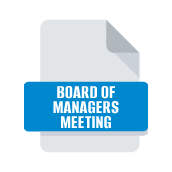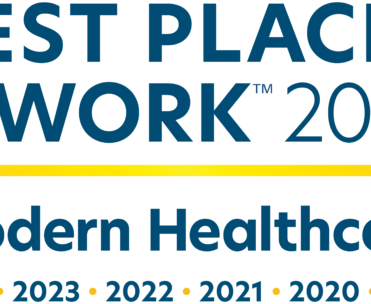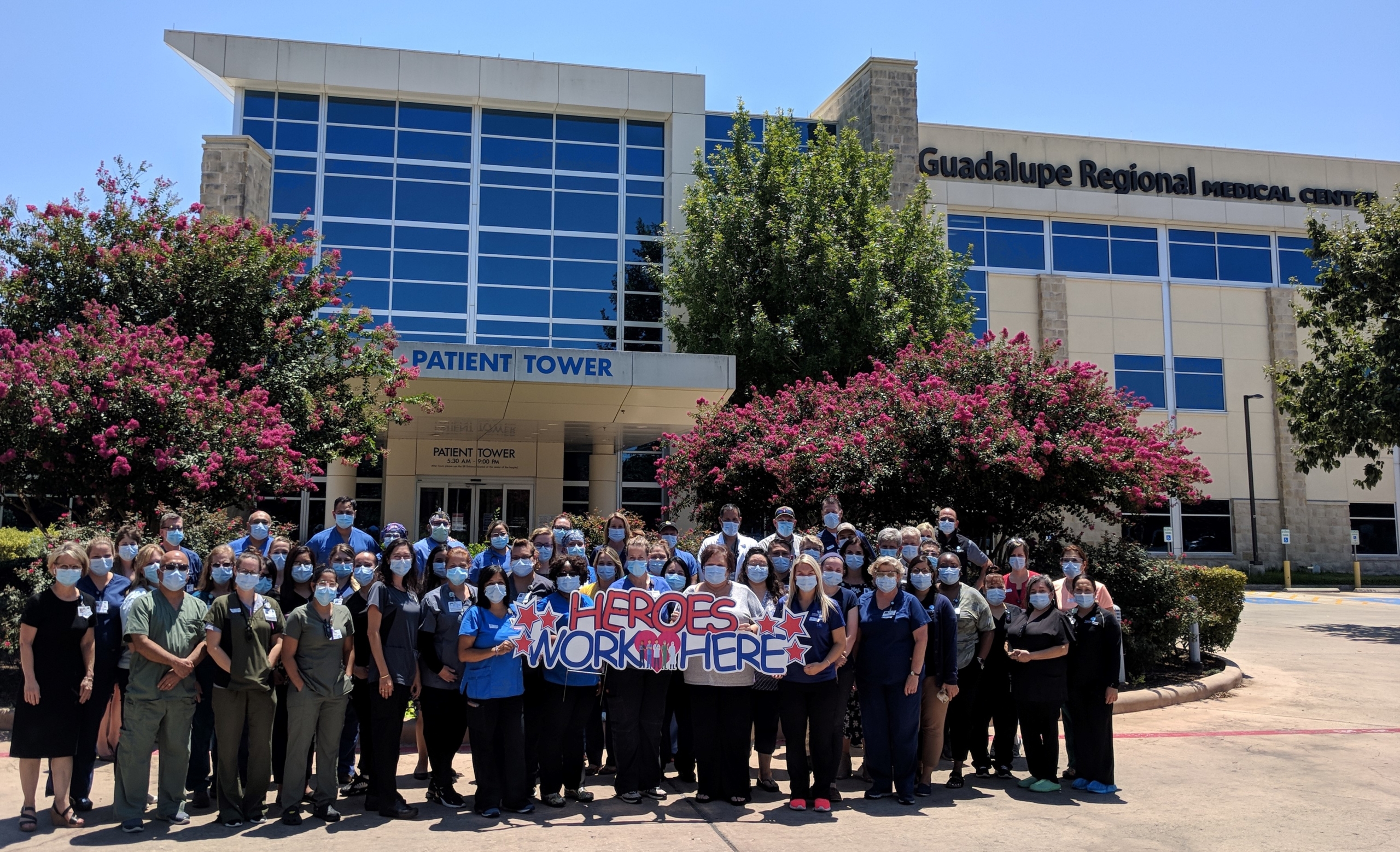
Behind the Masks: The Faces & Stories of GRMC’s Pandemic Responders
102 minutes
The year 2020 will be remembered as a historic, damaging and sorrowful year across the planet due to the COVID-19 pandemic. This crisis also served to spotlight the courage, compassion and competence demonstrated by those who actively supported and selflessly cared for others during this incomprehensible year. This is the story of how the staff of Guadalupe Regional Medical Center (GRMC), an independent non-profit community hospital, effectively rose to the challenge of a sudden summertime spread of COVID infection and sickness in and around Seguin, Texas, and of the many heroes who emerged in the process.
The amount and pace of change that has transpired this year has been so mind boggling, it merits a brief overview. In the final days of 2019, a mysterious novel virus was recognized in China. The virus was officially named COVID-19, an abbreviation of Corona Virus 2019. By February, the World Health Organization declared a global pandemic, a major outbreak was reported in Italy, and the US recorded its first death. In March, a national emergency was declared in the United States and by the end of that month New York City registered over 1000 COVID deaths. Massive lock downs were in effect worldwide, and humanity was on edge.
Despite a lack of cases in the southern states, the State of Texas followed federal guidelines and decreed a statewide shutdown for all elective medical procedures on Friday, March 13th. This was enacted as a pro-active effort to preserve Personal Protective Equipment (PPE) and medical resources. Upon this development, GRMC’s senior team immediately lept into action, spending the ensuing weekend developing, coordinating and implementing emergency “what-if” plans in coordination with the department directors and medical staff. The physicians who were most involved were the critical care intensivist, and the hospitalists who focus exclusively on caring for hospitalized patients.
The Emergency Department (ED) refined their protocols for managing infectious patients. The Inpatient Rehab Unit was converted to a Public Health Emergency (PHE) unit, providing 11 private rooms. All support departments began to stock provisions in case of a significant increase in patients. The facility transformed from one that welcomed the public to one in which most entrances were locked, visitors were only allowed under certain strict circumstances, screening stations were set up at the few open doors, and masks were required at all times. Despite these intensive preparations, there were only eight confirmed COVID patients admitted to GRMC over the spring months, giving the impression that perhaps our region would be spared, and casting doubt as to whether this was all “much ado about nothing”.
By early June, however, a curious uptick in positive tests was noticed in the ED. The uptick quickly translated into a sudden patient surge. On June 24th, over a dozen patients were admitted from the Emergency Department, all positive for the corona virus and requiring hospitalization. Collaborating with the core medical group of Drs. Sangha, Arenas and Lester, rapid decisions were made to create additional COVID wards for critically ill patients. The PHE was expanded into 22 semi-private rooms. The nine bed ICU was dedicated exclusively for COVID patients. The GI recovery bays were converted into a medical ICU, a previous GI recovery space was transformed into another COVID only ward, and by early July the Post Anesthesia Care Unit was converted into yet another COVID-only ICU.
By early August, over 200 COVID patients had been admitted in a span of 8 weeks. Forty of these patients died while hospitalized. On our peak day, there were 44 COVID patients hospitalized at GRMC, representing more than half of total inpatients. The Emergency Department was holding as many as 10 patients at a time waiting for a hospital bed to become available. Alarmingly, the positivity rate for COVID tests performed at one point exceeded 40%, reflecting the fact that Seguin was especially hard hit within Guadalupe County. In addition to the full throttle effort dedicated to this event, there was never a pause in providing round-the-clock care for other medically ill patients, emergency surgeries, to deliver newborns, and to perform diagnostic tests.
At the time of this writing, the initial patient surge has subsided. Because subsequent surges may occur in the coming months, we remain in full prevention and preparedness mode. The remarkable response to this medical emergency was made possible by a wide range of talented and dedicated individuals, each providing their own expertise in a complex situation. The faces and stories of some of these heroes have been chronicled here, in this collection of interviews conducted in July and August.
Robert G. Haynes, Chief Executive Officer
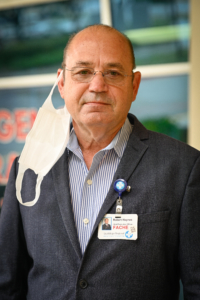 I have been in the health care business, either at the bedside as a respiratory therapist or as a hospital leader, for more than 40 years. Never have I experienced such a disruptive, historical event as this pandemic. Never would I have imagined that we would be converting recovery bays into ICU’s, overnight.
I have been in the health care business, either at the bedside as a respiratory therapist or as a hospital leader, for more than 40 years. Never have I experienced such a disruptive, historical event as this pandemic. Never would I have imagined that we would be converting recovery bays into ICU’s, overnight.
Regardless of the extent of the challenge, my confidence in our GRMC team never wavered. Over the years we have developed a strong culture of quality and safety, of transparent communication, of trust and relationships. We have recruited and retained outstanding clinicians and passionate support staff. We have been blessed with a phenomenal medical staff, who stepped up to provide clinical expertise and strategy during this difficult period. I could not wish for a more competent and dedicated Senior Team. All of these factors created the foundation for our successful COVID response.
As the “storm” hit our hospital, I reiterated several basic tenets. First, we must protect our staff by having appropriate, sufficient and readily available PPE. We must be able to test quickly to identify and trace any staff who are positive for the virus. We must bring in additional travel nurses and cardiopulmonary therapists. We must set up systems to allow staff who can to work from home.
I knew that this crisis could challenge relationships and create fear. To combat those negatives, we must ensure honest, accurate and constant communication. We must educate those who are understandably nervous, so that they are well prepared and confident about treating patients.
I was aware that the loss of elective surgeries would negatively affect our finances and that we might be stretched thin with less income and more expenses. However, the Governing Board and I agreed that our priorities must be staff and patients, and that the finances would be addressed in time. We rearranged work schedules and assignments, and never furloughed a single staff member.
I have always been proud of the care provided at GRMC; I have never been prouder of the staff with whom I am privileged to work.
Bhupinder Sangha, MD, Intensivist/Nephrologist
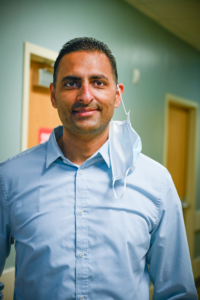 Being a doctor who cares for patients in the Intensive Care Unit, I am accustomed to seeing sick patients all the time. However, what I saw with COVID 19 is unparalleled to anything I have ever seen before. Many bacteria and viruses cause respiratory illness but this virus causes so many different issues that often times it felt like we were dealing with an enemy that could not be destroyed. ICU felt like a war zone where lives were lost too frequently.
Being a doctor who cares for patients in the Intensive Care Unit, I am accustomed to seeing sick patients all the time. However, what I saw with COVID 19 is unparalleled to anything I have ever seen before. Many bacteria and viruses cause respiratory illness but this virus causes so many different issues that often times it felt like we were dealing with an enemy that could not be destroyed. ICU felt like a war zone where lives were lost too frequently.
Reflecting on the past few months brings mixed emotions. On one hand, I was very impressed with our overall operation. Having worked in other health care systems, I especially appreciated the unique ability of GRMC’s administration to be excellent partners with the healthcare providers. They deserve a lot of credit in providing for the overall operations that above all included safety of all employees. The backbone of GRMC’s inpatient service is the hospitalist team consisting of Dr. Lester and Dr. Arenas. Their greatness was on full display over the last few months. None of our success would have been possible without them.
On the other hand, it is difficult for me to pat myself on the back after losing so many people from the community to a disease that is completely preventable. The spread of the virus may have slowed down in our region but as I write this today we are still losing around 1,000 people a day in this country to this disease.
I would like to say to the community that there are still so many unknowns. We do know that this virus affects everyone differently. Some people have no symptoms at all and others die no matter what we do. There are many proposed treatments but no definitive treatment exists. The best option is prevention. In order to prevent the numbers and cases from rising again in our community, people need to continue taking this disease seriously and following all the precautions they can.
Heather Patterson, RRT, Director of Cardiopulmonary Services
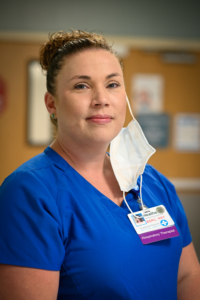 I kept hoping that COVID would not affect us, that we would have a quiet season like it appeared in March. However, the surge came, and came strong in June. I guess people don’t really believe in it until it slaps them or their family directly.
I kept hoping that COVID would not affect us, that we would have a quiet season like it appeared in March. However, the surge came, and came strong in June. I guess people don’t really believe in it until it slaps them or their family directly.
As respiratory therapists, our go-to equipment includes high flow oxygen through the nostrils without pressure, BiPap which provides non-invasive pressurized oxygen, and ventilators as a last resort for invasive, pressurized oxygen directly into the lungs. Any supplies we need have been provided for us – we have had amazing support from the top to the bottom of this hospital.
We have seen the very worst of this disease. In some patients, their mucus is so thick that we can barely suction their lungs. Some patients would improve really well, only to become critically ill again. For those who are critically ill but manage to beat the disease, their rehabilitation is long and hard. In fact, several of my staff and even I have been infected with COVID. Even though we are young and healthy, the sickness was really tough.
Tom Jones, Director of Pastoral Care
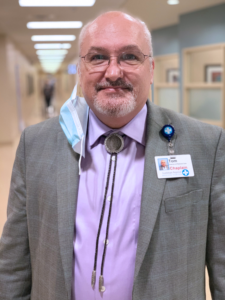 As the hospital pastor, I was approached repeatedly by staff members, patients and family members asking me to provide a spiritual explanation for this virus. Is God punishing us? Is this a rapture, or “roll call”? Is God cleansing the human
As the hospital pastor, I was approached repeatedly by staff members, patients and family members asking me to provide a spiritual explanation for this virus. Is God punishing us? Is this a rapture, or “roll call”? Is God cleansing the human
race? In each of these conversations, I first listened to the concerns and fears, and then responded with what I believe to be true. We live in a natural world, with natural and random occurrences, including pandemics. I do not believe God to be the source of harm or illness or death, and I do not believe that society is being punished.
I have seen the best of humanity in this crisis. GRMC has been exceedingly well prepared, empowering our managers to make critical decisions, providing an ample supply of PPE, ensuring excellent education and a culture of safety. The level of professionalism and compassion shown by our doctors and staff has been remarkable. I will never forget seeing one of our hospitalists, Dr. Lester, sitting on the bed of one of our COVID patients, holding her hand with her own gloved hand, assuring her that she would recover.
I have seen so much fear in these few weeks. Patients who are afraid that they will die without seeing their loved ones, concerns about “getting their things in order”, family members who are separated from their loved ones and only able to connect on Zoom or through the hospital room window. But I have also seen fearlessness by the doctors and staff members who confidently enter into these rooms, respond quickly, perform procedures, intubate critically ill patients, working tirelessly to heal others.
I have seen depression, related to so much loss. I have seen disorientation, solitude, and exhaustion. I have seen guilt (did we wait too long to bring in dad?). These have been heavy and intense weeks, but these have also been spiritual and powerful moments.
Daphne Blake, RN, MSN, Chief Nursing Officer
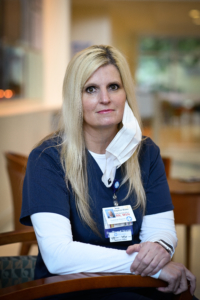 It is astonishing to look back on the past few weeks and realize just how much our hospital staff has accomplished in such a short time. We had to quickly recognize and adapt to escalating numbers of critically ill patients, create new COVID intensive care wards, change processes, basically recreate a whole new hospital to handle one group of infectious patients while also maintaining services for non-COVID patients. I have taken great pride in watching our people grow to levels that none of us could have imagined or anticipated. No doubt, our hospital will be even better as a result of this crisis due to the all the teamwork, innovations and realizations that have occurred.
It is astonishing to look back on the past few weeks and realize just how much our hospital staff has accomplished in such a short time. We had to quickly recognize and adapt to escalating numbers of critically ill patients, create new COVID intensive care wards, change processes, basically recreate a whole new hospital to handle one group of infectious patients while also maintaining services for non-COVID patients. I have taken great pride in watching our people grow to levels that none of us could have imagined or anticipated. No doubt, our hospital will be even better as a result of this crisis due to the all the teamwork, innovations and realizations that have occurred.
Despite the fact that I have been personally isolating as much as possible since March, I found myself coughing, with a fever and having heart palpitations while at home one Sunday evening in June. Although I did not feel really feel bad at the time I knew I needed to err on the side of caution before going to work or being around anyone so I called Dr. Sangha and discussed what was going on with me. He had me come into the hospital for a chest X-ray, EKG and COVID test.
To my shock, I was positive. I then stayed at home, alone, feeling trapped by my circumstances and deep desire to be back at work helping my team. My symptoms worsened very quickly, I hurt from head to toe, my heart rate increased, my palpitations more frequent and finally Dr. Lester and Arenas admitted me for dehydration and cardiac monitoring. Although it was a difficult time I feel blessed that my lungs were not affected, and that I recovered. I now have a personal understanding of how scary this disease can be, and especially how awful it feels to be separated from family when you are feeling your worst. I am grateful to our hospitalist group and all of the GRMC team that provided me with compassionate and quality care. I know this is their goal for every patient and that makes me so proud to be a part of such an amazing team.
It has taken an emotional toll on all our employees, knowing that we cannot allow visitors into the hospital, knowing that some of our patients have died separated from their loved ones. This is one of the cruelest aspects of this disease. We have done all we can to bridge that gap through Zoom calls, and through daily phone updates to family members. But while our staff are deeply compassionate and caring, they can never replace family. Since our staff must be fully covered and masked in the COVID units, patients are further traumatized by not simply not being able to see our faces.
If the community could see what each of our caregivers see each day in taking care of our COVID patients, I think they would better appreciate the importance of being responsible, and realizing the danger that can come with inadvertently passing on the virus.
Our dedicated doctors and staff, and the wonderful travel nurses and therapists that have come to assist us, are motivated to press forward each day because we know that we are making an enormous difference to the life of every patient and family member we treat. This is our purpose and our calling.
Penny Wallace, Chief Financial Officer
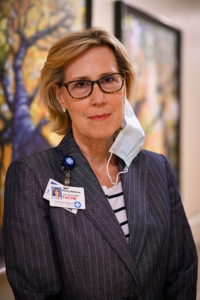 This has been an interesting time for me to observe our hospital’s response to this historical medical crisis, as I happen to be contemplating my upcoming retirement in six months while also reflecting on my 38 year career and journey at GVH/GRMC.
This has been an interesting time for me to observe our hospital’s response to this historical medical crisis, as I happen to be contemplating my upcoming retirement in six months while also reflecting on my 38 year career and journey at GVH/GRMC.
I was very proud to see our staff so competently responding to this crisis, and extremely impressed with the leadership and nimbleness demonstrated at all levels of our staff and in every department.
Prior to the pandemic emerging on the global scene, our hospital’s senior team was focused on various short and long term strategies, including physician recruitment, medical office and facility growth, predicting community needs, and maintaining organizational financial strength. The crisis put many of those plans on hold, but none were cancelled or derailed. This team has developed an unstoppable clear and strong vision for GRMC, and I feel very assured that the hospital rests in excellent hands.
Juan Arenas, MD, Hospitalist
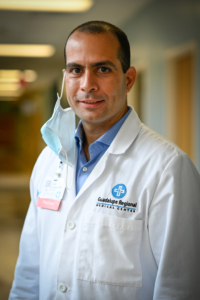 It is amazing to look back and see how quickly we staffed and equipped four different COVID units to keep up with the sudden patient load. Our usual hospitalist/critical care group of four doctors and one physician assistant rapidly transformed into a group of nine doctors and three physician extenders. Local primary care physicians Drs. Wright, Earnest, and James and David Rider immediately offered their help to cover our medical patients, and local surgeons Drs. Morales and Beste also joined the effort. Our nurse practitioner MaKenzi Burke was assisted by Russell Steitle and Abby Steck to successfully staff the hospitalist service and meet the demands for patient care. Effective and constant communication among team members was crucial to succeed during this quickly evolving situation.
It is amazing to look back and see how quickly we staffed and equipped four different COVID units to keep up with the sudden patient load. Our usual hospitalist/critical care group of four doctors and one physician assistant rapidly transformed into a group of nine doctors and three physician extenders. Local primary care physicians Drs. Wright, Earnest, and James and David Rider immediately offered their help to cover our medical patients, and local surgeons Drs. Morales and Beste also joined the effort. Our nurse practitioner MaKenzi Burke was assisted by Russell Steitle and Abby Steck to successfully staff the hospitalist service and meet the demands for patient care. Effective and constant communication among team members was crucial to succeed during this quickly evolving situation.
In addition to taking direct care of COVID-19 patients, my role was to collaborate in the design of the new COVID unit logistics, coordinating health care providers to staff these new units which demanded round-the-clock physician oversight. Dr. Sangha assumed oversight of the most critically ill patients in the COVID ICU. He did not go home for five days in a row since these patients were so sick and their conditions were changing rapidly. I came to the realization that we needed to develop a separate COVID unit for those patients who would not be able to recover, which is when we developed the palliative care COVID unit in collaboration with Dr. Nolan’s palliative care program.
We were working 12-14 hour shifts for 10-11 day stretches at a time. It was mentally and physically exhausting, but none of us ever thought to complain or to do anything other than to keep working, doing the best we could at all times. As we were working, we were also keeping up with the constantly evolving changes in recommended medical practice through the CDC guidelines, publications from prestigious medical peer-reviewed journals and publications including the Journal of the American Medical Association (JAMA), The New England Journal of Medicine (NEJM), Cell and “Up To Date” among others. We would divide article assignments, discuss, and develop protocols based on current recommendations and our own clinical observations. For example, Dr. Sangha reported that he was not having good results with the drug Remdesivir, initially recommended for the sickest of COVID patients. Nevertheless, Dr. Levett, Dr. Lester and I were seeing positive clinical outcomes with this drug in patients with severe illness, but not critically ill. We came to realize that this medication is in fact more useful in the early stages of the disease (such as for our PHE/SICU patients), but not as useful later in the course of the disease (such as for patients in the COVID ICU). Our suspicions turned out to be corroborated by medical studies with the same findings. We collaborated with the pharmacy for best practices on when to use, and need to maintain a stock of this medication to make sure every patient who qualified for this treatment had the opportunity to receive it early in their disease process without delay.
This illness is so unpredictable. We would see a patient improve, happy to expect a discharge home, only to be shocked to see the patient take a rapid turn for the worse and die unexpectedly. I signed more death certificates in these few weeks than I ever have signed in a full year of normal practice. While patients might present with a variety of symptoms, such as weakness, palpitations, or diarrhea, it was always the respiratory symptoms that would be the most concerning and serious.
Despite the fact that we physicians were literally face to face with these patients around the clock, none of us became infected. I am a firm believer that the reason we did not get sick is because of our compliance with using face masks and personal protective equipment (PPE) without a breach of the protocol we developed in our institution. It works. If everyone in the community would also wear face masks and practice social distancing, we would see a reduction in spread for certain. I believe this will become a cyclical disease, that we will see peaks and valleys in occurrence until an effective vaccine is developed. This is a serious disease with no effective treatment. As a community, we must realize its severity and try to prevent the spread.
I realized the unique culture of GRMC when I first interviewed here five years ago. Any hospital can have excellent tools, resources and staff, but it is the impressive culture of this hospital that provides the stability, teamwork, and collaboration needed to make the best use of those tools. Our hospitalist group shares the same principles, values and work ethics of the hospital, and a passion to provide the very best patient care. I see GRMC’s culture as open minded, ready to adapt, able to compartmentalize but still interconnected by its people who all share those same core values.
I am very proud to be part of this organization, and to have been able to help lead the physician response during this summertime crisis/COVID-19 pandemic. I am certain that patients are receiving the very best medical care possible right here at GRMC, for COVID-19 and for all other medical needs.
Jody Elliot, RN, BSN, Director of Surgical Services
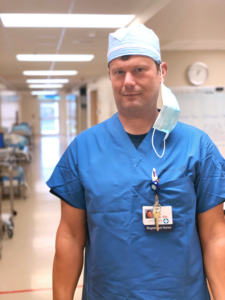 Our department was one of the first to be affected by the State decree to shut down elective surgery. My staff were worried about their hours, whether they would have full paychecks, and whether they might have trouble paying their bills. We were immediately assured that none of us would lose our job, and we were given opportunities to work in other parts of the hospital. OR staff are very used to our own little world, so it shook people out of their comfort zones to go to a new unit, to pick up housekeeping shifts, or to work at the entrances as screeners. But each of my staff reported back to me that these opportunities gave them new perspectives and appreciation of their fellow employees. One of our first priorities was to establish new protocols for caring for and transporting COVID patients in the operating room, such as for a few who required orthopedic emergency surgery and who also happened to be positive for COVID.
Our department was one of the first to be affected by the State decree to shut down elective surgery. My staff were worried about their hours, whether they would have full paychecks, and whether they might have trouble paying their bills. We were immediately assured that none of us would lose our job, and we were given opportunities to work in other parts of the hospital. OR staff are very used to our own little world, so it shook people out of their comfort zones to go to a new unit, to pick up housekeeping shifts, or to work at the entrances as screeners. But each of my staff reported back to me that these opportunities gave them new perspectives and appreciation of their fellow employees. One of our first priorities was to establish new protocols for caring for and transporting COVID patients in the operating room, such as for a few who required orthopedic emergency surgery and who also happened to be positive for COVID.
We were also challenged once it was decided to convert our post anesthesia recovery space into a COVID ICU. I have worked in other hospital settings, and I know for a fact that in other systems in this situation we would have likely experienced staff layoffs, we would not have been kept in constant communication about the status of the emergency, and we would not have been treated with such care for our own staff safety.
The fact that the hospital collaborated with Texas Lutheran University (TLU) to provide us with dorm apartments for overnight accommodations, so that our staff felt confident that they would not be bringing home COVID contamination to their family, is just one example of how GRMC gave us a strong sense of confidence and security during this unusual time.
Sarah Lester, MD, Hospitalist
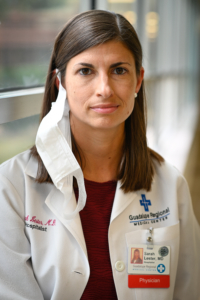 Drs. Sangha, Arenas and I decided early in our summer surge that we wanted to expose as few staff members as possible to this highly contagious disease. We agreed that we three would be the main doctors to enter into the designated COVID units, though we were very grateful to Dr. Morales for his crucial assistance and to the other doctors and providers who helped cover the non-COVID medical patients.
Drs. Sangha, Arenas and I decided early in our summer surge that we wanted to expose as few staff members as possible to this highly contagious disease. We agreed that we three would be the main doctors to enter into the designated COVID units, though we were very grateful to Dr. Morales for his crucial assistance and to the other doctors and providers who helped cover the non-COVID medical patients.
Those few weeks were definitely the most exhausting of my life, both physically and emotionally. In our line of business, we often deal with hard end of life situations. But never have I had to do so multiple times in the same day, and try to fill the role of the family member at the patient’s bedside when they pass away. Like all of us here at GRMC, it broke my heart to have families being separated from their loved ones. It was also mentally exhausting to be on constant alert and research mode, studying all the newest options for best practice for treating COVID patients, using the most up to date data on effective medications, sorting through constant changes and conflicting information. Having treated so many patients by now, my main conclusion is that there is no “silver bullet” or miracle cure. We believe that multiple approaches sometimes do help patients, but none are assured.
I want the public to understand that there are no constrictions on physicians from ordering certain medications. All physicians want what is best for our patients; we always order the medications and treatments we believe to be proven and effective.
This pandemic has changed my outlook as a physician. I have been given the opportunity to stand in for patients’ loved ones at the bedside. I have been included in family zoom calls, and tender phone calls between husband and wife, and have been a part of final goodbyes and very emotional life changing situations. As a result, I have an even deeper empathy, appreciation and compassion for my patients and their family members. I realize the significance of my role, and am honored by that privilege.
Learning from my colleagues outside of GRMC, and from those who have worked in other hospitals during this pandemic, I recognize that most other hospitals were not nearly as prepared as was GRMC. Dr. Sangha tells me that women always get things done, and one only has to look at the many well-prepared women on the hospital’s administrative team to see that he is absolutely correct. Before the surge, leadership was already stocking needed supplies. We all felt that anything we asked for, we would receive without question. On the first evening that patients were coming in faster than we thought possible, the administrative team was on the floors, setting up the new units, taking care of every detail. Unlike large corporate hospitals where leadership is miles away, or far removed, this team was on the ground, seeing for themselves what was happening and resolving problems before they occurred.
I simply cannot imagine getting better care than what we were able to provide at GRMC. We had all the needed resources, excellent staffing ratios, and a team of heroes who did whatever it took without complaint.
Kelly Cole, Executive Director of the Clear Springs Urgent Care Center
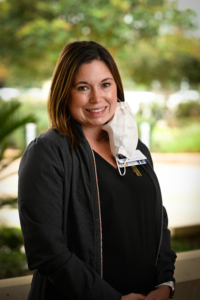 After a year of construction, our beautiful new Clear Springs clinic opened on April 3rd. Little did we know that within 10 weeks our clinic would soon become the designated outpatient COVID testing center for GRMC, and that all our clinical staff would soon become expert swabbers. We certainly had not expected to be challenged right from the start by not being able to directly obtain basic supplies like gloves and disinfectant wipes since we did not have an order history with regional vendors. Fortunately, the hospital was able to supply us as needed.
After a year of construction, our beautiful new Clear Springs clinic opened on April 3rd. Little did we know that within 10 weeks our clinic would soon become the designated outpatient COVID testing center for GRMC, and that all our clinical staff would soon become expert swabbers. We certainly had not expected to be challenged right from the start by not being able to directly obtain basic supplies like gloves and disinfectant wipes since we did not have an order history with regional vendors. Fortunately, the hospital was able to supply us as needed.
As a new leader in the organization, I was still trying to learn who people were and how our roles intersected when the crisis hit. This event really rushed that process, and allowed my path to cross with some of the folks that I worked with so closely as a part of our response to the COVID challenges. For instance, our Urgent Care would probably not ever really interact with post-operative care nurses, but they came out, helped, and really integrated with our team.
Because we needed to maintain proper isolation protocol for potential COVID patients, we set up a drive through testing center in the back parking lot. Unlucky for us, this new service coincided with record scorching summer heat on the unshaded pavement, especially grueling for staff who were fully suited with plastic gowns, hair bonnets and masks! Again, the hospital came through in sending additional staff to give our employees a welcome break during those long and busy twelve-hour days.
The staff from all of our employed physician offices jumped in to help in whatever way they could. That meant working weekend shifts when they are usually only scheduled for weekdays, or it meant sweating in 100+ degree weather for hours on end when they had been accustomed to working in the air conditioned climate of a physician office. For some, it meant calling patients to screen prior to coming to appointments and answering countless questions about our processes and response to COVID, or learning to use unfamiliar technology in order to take care of patients via telemedicine. For many, it meant being vulnerable to an unpredictable disease despite their fear. Each individual found a way to balance their personal anxiety with their desire to take care of our patients, community and organization. Though that was not easy or comfortable, we never heard a single “no” when asked for their help.
Yet another unexpected surprise for me was to find out that what I thought was a bad case of allergies and headache, was actually COVID. Yes, I tested positive in late June, and of course had to stay home to quarantine. Within days my symptoms grew to include a tight chest, shortness of breath, cough, and excruciating pain in all my bones. I spent five straight days and nights in bed, away from my family, and then finally recovered and returned to my team and clinic. It was exhausting, but also provided me a whole new understanding of the disease and its unpredictable course.
Kirk Chalmers, RN, Director of the COVID ICU, the Surgical ICU and the Medical ICU
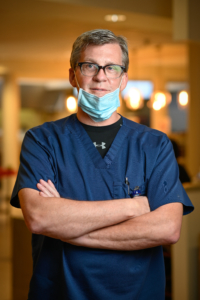 While we were all certainly keeping an eye on the crisis going on in the world and then in New York, it felt a little like preparing for a hurricane that is still far off in the distance. We were fortunate to have time to develop a PPE process, educating staff on proper donning and doffing, trying to keep up with the ever-changing CDC guidelines, and thinking through response plans. But our sudden surge still seemed to hit us without warning, overnight.
While we were all certainly keeping an eye on the crisis going on in the world and then in New York, it felt a little like preparing for a hurricane that is still far off in the distance. We were fortunate to have time to develop a PPE process, educating staff on proper donning and doffing, trying to keep up with the ever-changing CDC guidelines, and thinking through response plans. But our sudden surge still seemed to hit us without warning, overnight.
I was so impressed with everyone’s ability to think outside the box when the surge came. The Maintenance staff was amazing, coming up with air curtains for unit entryways, installing negative pressure equipment in five additional ICU rooms, helping us to protect staff and contain viral spread.
Staffing was our biggest initial challenge, as we had to staff several newly created intensive care units within hours. Administration was quick to offer incentives, and nurses from all departments, like Cath Lab and Hospice, were quick to volunteer and be highly flexible. We developed a system for identifying the most experienced and skilled nurses to be assigned to the most critical patient care areas, and triaging systems to determine which patients should be placed in which unit.
The travel nurses were lifesavers. Surprisingly, they have not necessarily brought new ideas for how we should be doing things here at GRMC, and in fact they have repeatedly told us that they will be taking away great ideas from us for future assignments. One of the nurses told me that she has told her friends: if you get COVID, come to GRMC, they provide great care. Another told me, you guys are the Chick-fil-A of hospitals – everyone is so nice! Others who were used to very stingy distribution of PPE at other hospitals are shocked at how readily available our PPE is for all staff. This feedback has been very encouraging and great validation for us, especially since we had to implement it all so quickly.
I have no doubt that the main reason for our excellent response is the leadership from the top. The Senior Team provided the environment we needed to do our best, and to empower us to make decisions. I have worked at other hospitals, where the attitude is that this is just another job. At GRMC, though, this is definitely a family atmosphere, where I know that leadership has my back. Interestingly, this dynamic also sets department directors up to have more accountability and to ensure transparent clear communication with our own staff.
We have also received a lot of encouragement from the community. The gift baskets of food and thank you cards are so appreciated and motivating. This is the most stunning event I have witnessed in my nursing career. The disease is brutal in how quickly it can weaken a patient, how quickly the patient can become critical. Patients present as being very air hungry, breathing fast, panting, with respiratory rates at alarming low levels. We have seen many “young” patients in their 40s and 50s struggling to breathe. Equally difficult has been to hear the desperation in the patient’s family members’ voices over the phone, seeing them camping out in grief outside of the patient’s windows, unable to come inside.
I have been taking this virus very seriously since March. In fact, outside of work I have been in social isolation, have not seen my grandkids at all and have avoided my son who has a weak immune system. I have seen firsthand how devastating this disease can be.
Denise Brown, RN, Clinical Coordinator for the Emergency Department
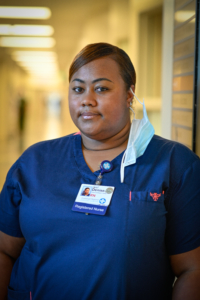 My boss, Nicole Patek, and I practically grew up here at GRMC. All of us here in the ED consider each other our family, and we are strongly committed to each other and our patients. That has been a big reason that we have done so well as a team taking care of this new challenge of COVID. Every day was a learning experience, but all of the staff quickly adapted to ensure we were safely providing the best care for our patients.
My boss, Nicole Patek, and I practically grew up here at GRMC. All of us here in the ED consider each other our family, and we are strongly committed to each other and our patients. That has been a big reason that we have done so well as a team taking care of this new challenge of COVID. Every day was a learning experience, but all of the staff quickly adapted to ensure we were safely providing the best care for our patients.
Just a few months ago, we started up a new program in the ED called Results Pending, providing a new system for caring for patients who were still in the diagnostic phase of their care. Back then, I thought that was the toughest project I’d ever managed. I had no idea what was coming in the spring!
In March, we realized that we needed to prepare for COVID patients. Immediately, all the involved departments were helping us set up isolation rooms, adding negative pressure rooms, purchasing air scrubbers and filters. One of the biggest challenges was the mental retraining to always protect ourselves first. As ED professionals, our first instinct is to always jump to help a patient in distress. With COVID, we had to force ourselves to stop and don all the appropriate PPE first. When our first ED employee tested positive, we became very meticulous about checking and reminding each other about this new reality.
Once the patient surge hit us, we set up an on call schedule to ensure additional staffing. Our committed staff managed to cover all shifts, with no complaints or questions. We set up new protocols, and started treating all patients, regardless of their chief complaint, as though they were contagious. I was shocked that some of our very ill COVID patients were young adults with no underlying health conditions. So far, our youngest positive patient was a 9-year old child. Some present with weakness, headache, flu like symptoms, loss of smell or taste. With COVID, you never know how it will present, who might get it and how bad it might get.
I consider it a blessing to work at GRMC. My nurse friends at other hospitals tell me how difficult it has been to obtain PPE. Here, Administration truly cares; they are visible and inspire people to be their best. Our ED doctors have been amazing, despite being exhausted with the pace and intensity. Our traveler nurses from all over the US have also been fantastic, fitting right into our culture and attesting to what an awesome hospital we have here. This event has taken us all back to our medical basics – clinical mind and compassionate heart, and reminding us of why we are here.
Ann Fleming, Housekeeping Aide
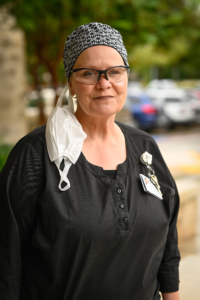 I took off from work for two days in late June, and when I returned, the world had completely changed! Suddenly, every single ICU patient was being treated for COVID, and several new units had been created for the overflow of even more COVID patients. I was asked to help with the cleaning of those ICU units. I knew this was a critical mission at a critical time, and I considered it my job and privilege to ensure the safety and cleanliness for the staff and patients in these units.
I took off from work for two days in late June, and when I returned, the world had completely changed! Suddenly, every single ICU patient was being treated for COVID, and several new units had been created for the overflow of even more COVID patients. I was asked to help with the cleaning of those ICU units. I knew this was a critical mission at a critical time, and I considered it my job and privilege to ensure the safety and cleanliness for the staff and patients in these units.
My bible says, Fear Not. Though I understood why other housekeepers and employees were nervous about the virus, I honestly felt more apprehension going into Wal-Mart than being at the hospital. Here, I know where I am, I trust my PPE and those who work with me. I was never afraid to be in these areas. As a Christian, I trust God to take care of me so I can take care of others.
They say “it takes a village”. It definitely did take all of us to look out for each other, to make sure we were all wearing our PPE correctly and securely. I would even correct the doctors sometimes, pointing out something they could not see about their masks, making sure we were all sealed and appropriately protected. I am amazed by the fantastic doctors, nurses and therapists here; each one so dedicated, professional, and caring.
In order to protect us as much as possible, the hospital policy was that housekeepers would only enter the patient rooms after a patient had been discharged. Otherwise, we would support the nurses and aides who performed many of the cleaning duties.
I remember one particular patient, a Hispanic gentleman in his 50s, who was so sick and so scared. He said he wanted someone to pray with him. I asked and obtained permission to go into his room, where I held his hand, and together we prayed. Just as I saw his fear going in to his room, I could see and feel his sense of peace, comfort and gratitude after we prayed. It makes me tear up now, knowing that two weeks later that patient died. I had such empathy for family members as they looked through the patient windows, seeing their loved one on a ventilator, understanding how helpless they felt.
I imagine they felt as I did when my husband was critically ill last year – praying for the best yet preparing for the worst. This virus is indiscriminate. It does not care who you are or where you come from. Yet, if you have underlying conditions it is like you have a target on your back.
Amy Anderson, RN, BSN, Director of the Public Health Emergency and Intermediate Care Units
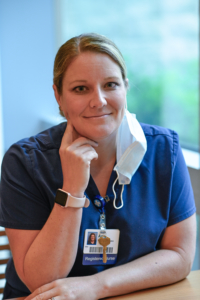 It seems as though my many past positions at GRMC have helped set me up to take on this newest role setting up and overseeing the Public Health Emergency (PHE) unit, the Intermediate Medical Care Unit (IMCU), and the Surgical Intensive Care Unit (SICU). I have helped manage the Emergency Department, the Intensive Care Unit, Trauma and Emergency Management coordination, and have helped set up the new electronic medical record. All of those helped me manage this recent COVID event.
It seems as though my many past positions at GRMC have helped set me up to take on this newest role setting up and overseeing the Public Health Emergency (PHE) unit, the Intermediate Medical Care Unit (IMCU), and the Surgical Intensive Care Unit (SICU). I have helped manage the Emergency Department, the Intensive Care Unit, Trauma and Emergency Management coordination, and have helped set up the new electronic medical record. All of those helped me manage this recent COVID event.
We have been super well served by our long-term emergency planning partner, the Southwest Texas Regional Advisory Council (STRAC). This organization’s mission is to help coordinate emergency responses between hospitals in our region. In this event, they have done a fantastic job helping us get travel nurses and therapists, and to acquire medical equipment and PPE. Since GRMC is an independent hospital, we were able to get direct and immediate support and not have to navigate through a big multi-hospital system.
June 24th was the day it really hit hard, almost seemed like the stuff you see in the movies. Twelve admissions through the ED overnight, all positive and many very sick. By comparison, prior to this date we had seen less than ten positive patients in total since March. We were afraid we might run
out of respiratory care equipment, but fortunately we had enough. Our own Chief Nursing Officer was admitted to the hospital, meaning that a team of us nurse leaders immediately coordinated game plans for setting up new patient care units. Before we had the help from traveler nurses, we were having to ask our staff to work long days and shifts.
Dr. Sangha, who provided hospitalist care in our ICUs, has been a Godsend for us. He is smart, calm, knowledgeable, good with families, realistic, and an all around wonderful physician. Drs. Arenas and Lester were equally committed, dependable, and amazing.
Most of our COVID patients came from home. Only about 15 came from local nursing homes. In July we accepted transfers in of patients from Val Verde and Yoakum, a testament to how overwhelmed those facilities had become as well. The physicians soon developed algorithms for which lab tests were best indicators for likely recovery, although it was never easy to predict. Some patients would do very well, only to decline again quickly.
Sometimes, it became evident that a patient was not going to survive. Those were awful situations, since we were unable to have the family be with the patient as he/she passed away. We had a team of supporters who helped set up Zoom audiovisual calls with all patients, so at least there was that communication. Some families stood outside the patient windows, despite the 100-degree heat and difficult situation. This was the toughest part of all of our jobs, it was very sad.
In addition, staff are all completely garbed in PPE, making us seem less than human to the patients. One of our biggest efforts was to try to retain the humanity of caring for the patients, despite the awfulness of not having family and not being able to see our own faces.
Kristen Gomez, PT, Assistant Director of Rehab Services & Jo Beth Perkins, PT Physical Therapist
Kristen Gomez was recently promoted to Assistant Director of the Rehab department, and Jo Beth Perkins is a new graduate who started working at GRMC 8 months ago. What a year for her to get started in health care!
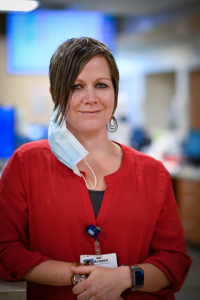 Kristen’s story:
Kristen’s story:
I am so impressed with how quickly changes can be implemented at GRMC. For example, one day we realized the need to initiate post-acute care rehab care for COVID patients, and the next day it was in place in our Inpatient Rehab Unit. I cannot imagine another hospital where the teamwork is so hardwired that such changes could be made so quickly and well.
We are starting to see people with what I am calling “quarantine induced debility, or weakness” on the outpatient side of our service. Without social interactions, without getting out and about, and because of the summer heat, we are noticing that many people are becoming very sedentary just watching TV or on the computer. This means that muscle tone is lost, people become more vulnerable to medical events or injuries, and that their recuperation will be slower. Being in good physical shape and active is very important anytime but especially now with the threat of COVID infection.
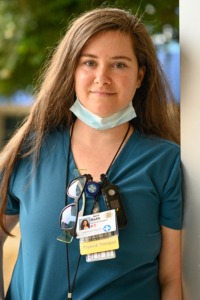 Jo Beth’s story:
Jo Beth’s story:
I rotated at several big hospitals during my training, so I have experienced a typical structure between physicians and clinicians at those facilities. In a big corporate hospital, there is little if any opportunity for face-to-face communication and collaboration with physicians, so care ends up being a bit
disjointed.
At GRMC, however, I have loved the fact that I am talking directly to the physicians each day, they are very approachable and friendly, and genuinely interested in developing good patient care strategies with the clinical support staff. The same is true for all the patient care team – nurses, respiratory therapists, housekeepers. This is always true here, but especially important in the treatment of our COVID patients.
You might not realize that physical therapy is very important to these patients, but in fact it is essential. Many of the critically ill have been on a ventilator, immobile, for weeks. We begin to see them when they are very weak, possibly able to move their bodies for only one minute at a time. We begin slow, having them sit up in bed, then eventually having the patient sit on the side of their bed, then standing and then walking with assistance. This is a slow process, as the disease has taken a huge toll on the sickest of our patients. Just sitting on the side of the bed can be really fatiguing.
In addition, their oxygen levels and blood pressure are low, heart rates are high. In a non-COVID patient, these levels might even be so alarming as to require a rapid response team, but we have learned that with COVID these extreme vital signs are actually to be expected. One of the difficult aspects for us has been to have to wear all the needed PPE to care for these patients. It is time consuming to put on, it is oddly bulky and uncomfortable, and it is so impersonal!
We work with patients who are having a lot of anxiety due to their air hunger. We teach them how to conserve their energy, helping them regain control and motor strength, thereby renewing their confidence in being able to safely return home. I have been shocked to see so many younger patients with minor health histories being so weakened by COVID.
Scott Mozisek, PharmD, Director of the Pharmacy
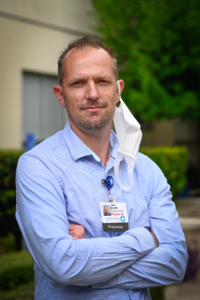 When I took over the pharmacy director role at GRMC, we were in the midst of a several widespread national drug shortages. I thought that was the toughest situation I would ever have to navigate, but in fact it turns out that was just excellent training for the current situation where I have been working nonstop to obtain necessary medications to treat our COVID patients.
When I took over the pharmacy director role at GRMC, we were in the midst of a several widespread national drug shortages. I thought that was the toughest situation I would ever have to navigate, but in fact it turns out that was just excellent training for the current situation where I have been working nonstop to obtain necessary medications to treat our COVID patients.
Remdesivir is one of the medications that has been found to be effective if given early to a COVID patient even though it is not FDA approved. Initially, its manufacturer donated vials to the Federal government, who in turn allocated it to the States, who in turn provided to hospitals with verified need. Now the program has changed so that you have to buy it through approved distributors and wholesalers. That has been a huge task in itself.
In addition, the country has been experiencing COVID related shortages of medications used to for intubating patients, for stopping viral replication, for inhibiting cytokine immune storms, and inhalers to help patients breathe. In all of these cases, we are constantly working to obtain product and stockpile as needed. We are fortunate to be working hand in hand with Dr. Sangha to collaborate on priorities and most effective use of the medications we do have available for our patients.
Another challenge for our department was setting up the various new ICU units, and the pharmacy dispensing systems for each. I am so impressed with the level of professionalism within our pharmacy department, from our amazing techs to our dedicated pharmacists. For each of us, this is our profession, not just a job.
Mark Porter, Director of Materials Management
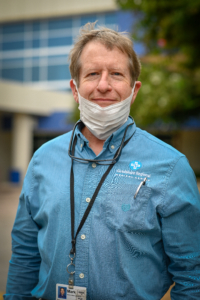 COVID has totally changed our normal systems for ordering medical supplies. Before, we would contact our suppliers and normal chains of distribution; maybe spend 3-4 hours placing a large order. Now….we have to use multiple vendors, find vendors, investigate new vendors, coordinate with STRAC, consider new products….all of which might take us 3-4 days!
COVID has totally changed our normal systems for ordering medical supplies. Before, we would contact our suppliers and normal chains of distribution; maybe spend 3-4 hours placing a large order. Now….we have to use multiple vendors, find vendors, investigate new vendors, coordinate with STRAC, consider new products….all of which might take us 3-4 days!
For example, masks. Before COVID, masks would cost about 70 cents each, and were easily obtainable. However, the huge worldwide demand for masks turned the system upside down. The US government started buying up inventory so that no one hospital system could horde the supplies, but that in turn meant that our previous supply chain was running dry. We were fortunate to work with STRAC for allocations, but it has still been a hit and miss project of what is available and when. The products keep changing, which means we need to continue to test staff for safe face fitting. We were forced to start working with newly developing vendors, industries that were not accustomed to this line of business and whose representatives were not well informed. By this point the same mask that used to cost less than a dollar was now going for $5 or more. Because our number one priority is staff safety, we were buying every legitimate mask we could find.
Those same shortages were soon seen with other PPE, like gowns, caps, eye protection shields, shoe covers, gloves. Some of these items came direct from China with boxes printed only in Chinese that none of us were able to read. It was also interesting to realize that an “extra large” in Chinese gowns translates to more of a medium size here.
We have been stockpiling and going through an incredible amount of product to keep up with the patient load. For example, in July our staff was using at least 700 caps and masks and shoe covers per day! We went through 4000 gowns in just ten days.
When we realized the extent of the patient surge, I knew the main thing I had to do was to order and stockpile as many supplies as possible, with space being our main limiting factor. Medical equipment was also a major issue for us, ensuring that we brought in additional ventilators and breathing equipment. Our Materials Management staff worked long hours calling vendors, receiving and inventorying supplies, implementing new strategies, and always making sure that staff safety was our number one concern.
It is very rewarding to hear our contract nurses notice how we go above and beyond to take care of our staff, and for our sales reps to reinforce that GRMC is truly unique in being very progressive, innovative, engaged, and with a remarkable safety-minded and friendly culture.
Richard Power, Director of Dietary Services
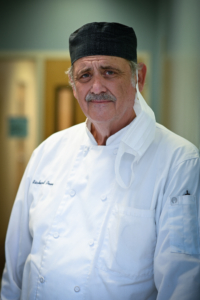 The dietary staff and I feel very much a part of the GRMC family – we are never treated as though we are a separate “contract” company. We are employed by Morrison, which contracts to provide food services to GRMC employees and patients, but we definitely consider GRMC our home.
The dietary staff and I feel very much a part of the GRMC family – we are never treated as though we are a separate “contract” company. We are employed by Morrison, which contracts to provide food services to GRMC employees and patients, but we definitely consider GRMC our home.
In March our dietician, Katelyn Warshaw, started researching best nutritional treatments for COVID patients on ventilators, and then coordinating and planning with the Material Management department to acquire sufficient tubing and feeding products to prepare for a possible surge. We also rearranged the hospital dining room to allow only one chair per table so as to ensure social distancing and eventually replaced the self-serve salad bar with pre-packaged salads. We enhanced our sanitizing protocols as well. Anytime I needed any additional sanitizing supplies, the Maintenance department was not only quick to respond but they even delivered directly to the kitchen. Awesome teamwork all the way around.
When the actual surge came, hospital leadership made sure that our staff safety was a priority. Our dietary associates were not expected to enter the rooms of COVID patients, so we coordinated with nursing to pass off patient trays at the front of each unit. The daily meetings organized by Administration provided me with ongoing status updates, that I then passed on to my staff. This helped us all feel informed and prepared. We were all united in understanding that taking care of sick people is our goal. I was especially proud of our hospital when we even started taking in transferred patients from outside of our community, emphasizing how committed we were to our mission.
Morrison is the health care division of our parent company, Compass. There are many other hospitality and food divisions of the company who specialize in schools, universities, businesses, and sporting events. ALL of those divisions have been hit hard by the coronavirus, and there have subsequently been thousands of employees furloughed as a result. Those shut downs have caused more downstream impacts, like fewer deliveries and fewer delivery routes. Illness in the produce and meat packing industries have also created food shortages for us. While we prepare for another patient surge here at GRMC, we also recognize that other food related impacts may still be coming in the fall and winter.
I have worked in many hospitals through my career with Morrison. What makes GRMC stand out and be so successful is that leadership here truly cares and is very engaged. That culture brings out the best in all of us. Corporations care about bottom lines, GRMC cares about patient outcome. There is also a prevailing attitude here that there is always an answer to every problem – it is just a matter of finding the right people and ideas to find that solution.
Elaine Bennett, CEO of the Guadalupe Regional Medical Foundation (GRMF)
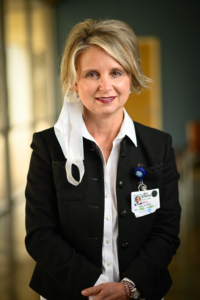 I like to ask myself each day, how can I make a difference to the GRMC and GRMF? Before COVID, that answer always revolved around raising funds for the hospital. However, social distancing certainly changed opportunities for group gatherings and traditional fund raising. On Friday, March 13, 2020 everything
I like to ask myself each day, how can I make a difference to the GRMC and GRMF? Before COVID, that answer always revolved around raising funds for the hospital. However, social distancing certainly changed opportunities for group gatherings and traditional fund raising. On Friday, March 13, 2020 everything
changed. The foundation was working on the annual Race 2 Raise annual 5K scheduled in April. We were so excited about creating our first Fiesta medal. All those plans ended and we learned that adaption was our new norm.
When attending the daily huddles at the command center, every department reported the condition they were encountering. Everyone was professional and committed to addressing the disease and taking the best care of the patients while maintaining their own health and safety. However, I could sense the fear and worry related to this very serious disease. From my standpoint, I began to switch my focus from fundraising to how to help our employees. Temporary housing at Texas Lutheran University (TLU) came to my mind to mitigate the fear staff had of infecting their own families. Indeed ,we were able to arrange dormitory use for our front line staff.
I also thought about the access to grocery shopping for our employees. With reduced hours at the grocery store, our employees had difficulty even grocery shopping. Our local WalMart generously agreed to create a designated shopping time frame for GRMC employees.
Another area that came to mind is the loss of jobs in our community and how that affected our staff and community members. Food insecurity has been present in our community and the pandemic amplified that need. Mega distributions were held in larger communities and I kept asking the food bank when Seguin would be on their radar. We were grateful to the San Antonio Food Bank and Seguin City Manager, Steve Parker, who partnered with us to begin hosting these local distributions. As of this writing, we are on our 4th and the 5th one planned, each time distributing over 100,000 pounds of food. We are privileged to be able to assist in providing a hand-up in these uncertain times. In addition, GRMF has been instrumental in setting up a hospital-focused food assistance program for our own employees, giving out between 30-90 supplemental food boxes each week since spring.
Local corporations have been phenomenal in their ongoing support of our healthcare heroes. The Seguin Economic Development Council (SEDC) helped coordinate a mask drive from those local industries who had additional stock. Niagara Water donated hundreds of bottles for our staff and food drives, Bimbo Bread provided a much appreciated bread give away for our staff, Pure and Gentle provided bottles of hand sanitizers, and Vitesco came to the rescue when we were running out of shoe covers.
Whitney Bishoff, one of the Nursing Instructors at TLU, was quick to create a training video for our staff on how to properly don and doff PPE, and there was an overwhelming response by dozens of local seamstresses to sew fabric masks.
In the meantime, we had and continue to have community members reaching out wanting to know how they can help. Dr. Phil Rinn and Ian Burden, CEO of Alamo Group, organized an amazing and timely collaboration of local corporations to offer assistance.
With the generous donations they collected from Alamo Group, Caterpillar, CMC, GVEC, EPMP, Tyson, Republic Plastics, Minigrip and Tyson, over $100K was collected since July to purchase rapid response COVID testing equipment for the hospital’s lab. Already, that equipment has performed over 1,000 tests and helped expedite diagnosis and treatment for these patients.
During our peak surge, I reached out to the churches for prayer. That response has been heartwarming and continuous. Local churches have donated iPads to help facilitate patient/family communication, raise funds for medical monitoring equipment to give to our patients upon discharge, and provided innumerable baskets of goodies, healthy snacks and motivating thank you cards for our staff. Special thanks to St. Andrew’s, Faith Lutheran, Hillcrest Church, First Baptist and the Greater Refuge Pentecostal Church.
Liz McCown, JD, Risk Manager, Legal Counsel and Public Information Officer
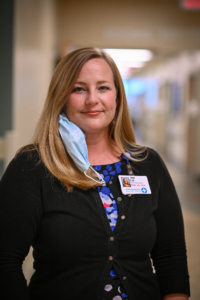 This was such a confusing and unprecedented time, even in what might seem the most mundane of issues. For example, the State lifted the Open Meetings Act requirements during the emergency orders enacted in March, which changed our system of posting and conducting the GRMC Board of Managers meetings. Transitioning to Zoom also prompted new challenges and a need to interpret regulations on the fly and without precedent.
This was such a confusing and unprecedented time, even in what might seem the most mundane of issues. For example, the State lifted the Open Meetings Act requirements during the emergency orders enacted in March, which changed our system of posting and conducting the GRMC Board of Managers meetings. Transitioning to Zoom also prompted new challenges and a need to interpret regulations on the fly and without precedent.
As the hospital’s Public Information Officer, I was responsible for reporting accurate data yet it was difficult to coordinate our own data with the numbers being given to the County by the Texas Department of State Health Services. Privacy regulations precluded our organization from sharing the names of those who had passed away at the hospital directly with the county, causing frustration for County officials who had to wait for the Texas Department of State Health Services to process the information and provide numbers back to the County.
The March and April 2020 time frame saw multiple executive orders from Texas Governor Greg Abbott suspending elective procedures for the purpose of preserving personal protective equipment (gloves, masks, gowns etc.) to ensure hospitals had enough PPE to treat COVID-19 patients. Texas Hospital Association would issue guidance on the executive order, then Texas Medical Board would weigh in too a few days later. We were constantly reviewing our processes and reworking them to meet the ever-changing requirements….then they would change again and the focus shifted from PPE preservation to hospital capacity.
While all of that was going on, we also filed paperwork to allow GRMC to use our Outpatient Surgical Center to temporarily house inpatients if necessary for a COVID-19 patient surge as during that time New York was assembling field hospitals and bringing in Navy ships to house patients. I was grateful for the many long-standing relationships we have built with City and County officials, and the members of our local media and The Gazette and KWED. Together, we worked hard to ensure that we were informing the public in an accurate and consistent manner.
Dolores Major, MD, Anesthesiologist and GRMC Governing Board Member
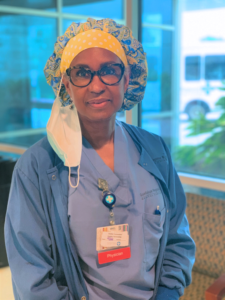 The coronavirus news of the cruise ships, of New York, of New Orleans….that all seemed like a bell in the distance, something that happens “over there” and in big cities. Nevertheless I gathered our Anesthesia provider team to discuss and research how we could be helpful in case our own facility was impacted. We listened to Anesthesia Society webinars on how to convert anesthesia machines into make shift ventilators, we experimented with adding viral filters to the machines and even engineered ways to build an effective “DIY” N95 mask. We thought through ways that the doctors and nurse anesthetists of our team could supplement the bedside care provided by the hospitalists.
The coronavirus news of the cruise ships, of New York, of New Orleans….that all seemed like a bell in the distance, something that happens “over there” and in big cities. Nevertheless I gathered our Anesthesia provider team to discuss and research how we could be helpful in case our own facility was impacted. We listened to Anesthesia Society webinars on how to convert anesthesia machines into make shift ventilators, we experimented with adding viral filters to the machines and even engineered ways to build an effective “DIY” N95 mask. We thought through ways that the doctors and nurse anesthetists of our team could supplement the bedside care provided by the hospitalists.
But even so, the day that reality and the patient surge hit, we honestly felt unprepared. My words were confidently saying, “we got this!”, but my heart was sinking and certainly breaking once we had our first coronavirus death. It got personal once the illnesses and deaths started affecting people I know, people in my church, and staff members. We found out that all those contingency plans we had devised within our own Anesthesia department were not needed after all, as the hospital had already planned well to ensure sufficient ventilators, masks and providers.
There were so many changes, so rapidly implemented, that it felt a bit like shifting sand. Everything about my “normal” routine in the OR was turned upside down. The Post Anesthesia Care Unit was now a COVID ICU, elective cases were cancelled, communication was made all the more difficult under layers of masks worn by every employee. Once it was realized that there was a high rate of community spread, we realized we needed to manage every patient as though they may be infectious even if asymptomatic. In our role as anesthetists, we are up close and personal with every patient while intubating and extubating, while managing airways, while assessing the patient’s face and breathing – all of which must be done with the patient’s face unmasked. We came up with innovative ways to use plastic sheeting and scaffolding to provide excellent patient care while also protecting the staff. The additional air scrubbers were appreciated, but also loud. So between the noise, the new protection apparatus, the multiple masks….I would go home hoarse and physically exhausted, feeling like I had been yelling at an all-day pep rally.
As a physician and board member at GRMC, I am so very proud of the coordinated response we provided. The morning huddle meetings were extremely informative, which in turn allowed me to inform my Anesthesia team of the daily changes. I never felt alone or “thrown to the wolves” – we all felt very well supported, safe, and that GRMC “had our back”. I was in awe of the hospitalist group and staff who worked nonstop to provide excellent care for our patients.
Rhonda Unruh, RN, VP of Quality
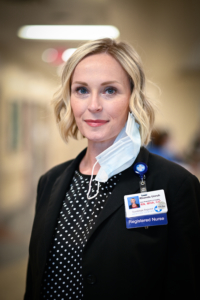 As early as December, we began watching the news of this virus emerging overseas. My background in Infection Control and my previous experience in tracking possible outbreaks of H1N1, SARS and Ebola caused me to be wary of this new virus. Once the disease began to spread uncontrollably in NYC, we began to ask ourselves if this could happen here. By mid March we were preparing in earnest for limited visitors, screening stations, setting up the PHE Unit, and developing contingency plans. It seems that every week something new was being required or recommended, though there were few patients and the general sense was that we would not be affected.
As early as December, we began watching the news of this virus emerging overseas. My background in Infection Control and my previous experience in tracking possible outbreaks of H1N1, SARS and Ebola caused me to be wary of this new virus. Once the disease began to spread uncontrollably in NYC, we began to ask ourselves if this could happen here. By mid March we were preparing in earnest for limited visitors, screening stations, setting up the PHE Unit, and developing contingency plans. It seems that every week something new was being required or recommended, though there were few patients and the general sense was that we would not be affected.
We never imagined how quickly and intensely we would in fact be affected. On June 23rd we had 16 very ill COVID inpatients – the next day that increased to 26 inpatients. On July 6th we reached our first peak of 44 inpatients. As the surge grew in the region, we even accepted transfers into our hospital from the Valley and Yoakum.
In addition to the increased volume of patients, many required critical care, leading us to rapidly adapt our pandemic plan to meet this need and create additional critical care capacity. There was no time to sit on decisions; we had to make the best decision possible and tweak as we went. Everyone involved stepped up to contribute and lead the necessary effort to manage this crisis. My role evolved into sharing the Incident Command role with Mr. Haynes, with close and constant collaboration with the Senior Team, nurse managers, physicians and really every single department manager.
Social distancing changed normal ways of conducting group dynamics in a disaster situation. For example, we could no longer use the smaller conference room for our command center; we had to quickly convert to a virtual format, relying on Zoom calls and electronic tracking sheets to keep the team informed. Keeping close track of data was essential to our response, monitoring everything from patient symptoms, admissions and discharges, PPE supply and use, lab tests, medication inventory, and medical equipment. It was important that we have accurate information, and that the data was communicated with all managers in a reliable and consistent manner so that each leader could make the best decisions for the safety of our patients and our staff.
The safety of our staff was a priority throughout this response, and the teamwork to make this happen was inspiring. Some of our own staff and/or their families became sick, leading to staffing challenges in some areas; GRMC staff pitched in wherever needed. Laurie Garrison (Employee Health Nurse) pretty much became our own Public Health Nurse, tracking and analyzing all staff infections and illnesses. The Quality department created protocols and provided PPE training around the clock. Tom Jones (Pastoral Care) and Chris Mata (Teddy Buerger Center) checked in on staff to offer counsel and support. It was very important to us that we respond to our employees’ anxiety and questions, and ensure that we were protecting their health.
The surge has subsided for now, but we are preparing for the potential to have to re-initiate our plans as needed. I think that masks will be part of our lives for a while, that we will need to continue to use caution while not allowing fear to dominate our plans. My family and my faith sustain my confidence in the future, while I also know that we can count on the excellent staff at GRMC to be up to any new challenge or surge that comes this Fall.
Steve Peth, Executive Director of Facilities & Joey Ancona, Director of Maintenance
Steve has been leading GRMC’s facility and safety programs for 18 years, Joey recently joined the staff as Director of Maintenance.
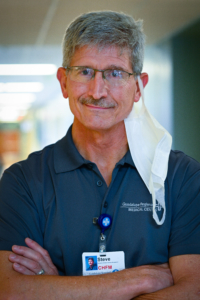 Steve’s story:
Steve’s story:
At the beginning of June, I completed a self-assessment facility survey about COVID preparedness. I remember thinking: yep, we have done all we need to do, not much else for us to do to prepare for possible patient surge, maybe this whole COVID scare has just been blown out of proportion. And then….the
whole world seemingly changed overnight. We went into overdrive immediately. Extra beds were brought over from off site storage so that we could convert the PHE rooms into semi-privates. We devised systems to provide negative air flow to the patient rooms in an effort to protect staff as much as possible. Tony Lopez, our maintenance assistant, was given the job of figuring out how to create a frame and fixture to hang “plastic finger” door curtains at each new COVID unit – he did a fantastic job.
The housekeeping staff was scared. Several of them had personal experience already with a loved one or friend getting sick with the virus, and the daunting new process of donning and doffing PPE prompted fear and tears. I certainly understood, but this is what I told them: You know Mr. Haynes, you know our Senior Team. Many of them have sons or daughters or other family members who are working right on the GRMC nursing front line caring for these patients. Would they put their family at risk if they did not firmly believe in our PPE effectiveness? Would they ever consider putting any of our staff at risk? That seemed to hit home with all of them, they understood that we are ALL in this together, and they jumped right in to help.
Another area where we were very engaged was with coordinating additional patient care equipment like hi-flow oxygen valves and BiPap machines. As always, Larry Kaiser was our quiet hero, busily and competently putting together newly acquired equipment at all hours of the day and night.
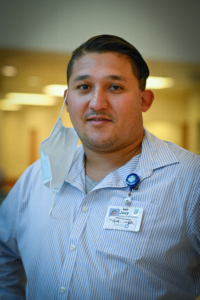 Joey’s story:
Joey’s story:
Our job was to support the staff quickly, setting up the units, and providing assistance throughout the facility. I was asked to find and set up plexiglass shields wherever there was staff/patient interactions such as at check in and screening stations. Some of the staff were very appreciative, some felt that the shields got in the way of their work. It was challenging to try to balance staff safety needs and desires. We brought in additional hand sanitizer, HEPA filters, always looking for ways to improve our system. Having worked at several other facilities, what I see that is different here is the leadership.
The Administration team didn’t wait to have concrete final solutions for each problem – instead, they encouraged and supported us to do the best possible at each opportunity. That allowed us to innovate, to change constantly. We were directed to do the best possible job we could, and that we would worry about the costs later. Do what you have to do to make it right. When the going got tough, the whole leadership team buckled in and set the tone. We were all in this together, around the clock.
Laurie Garrison, LVN, Employee Health Nurse
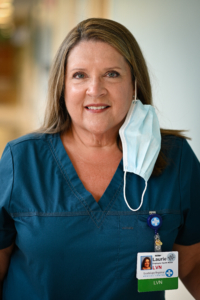 I feel certain that I was meant to be here at GRMC, in this position, during this emergency. I learned a lot at my previous career as the school nurse for Oakrun Middle School in New Braunfels, noted for being the first school to have to close down for one week in the mid 1990s due to an H1N1 viral outbreak.
I feel certain that I was meant to be here at GRMC, in this position, during this emergency. I learned a lot at my previous career as the school nurse for Oakrun Middle School in New Braunfels, noted for being the first school to have to close down for one week in the mid 1990s due to an H1N1 viral outbreak.
Our first GRMC employee exposure to COVID happened in mid April, which is when we began implementing our process for testing and tracing. Now, I have a whole file drawer dedicated to files of the 70+ employees who have since tested positive, all who fortunately have recovered as of this date. At first, we were able to trace back to patient exposures, but before long it was clear that new cases were arising as a result of community spread. One thing that has surprised me is how wide ranging all the symptoms and presentations have been, from very mild to very significant requiring hospitalization, from fever to cough to GI to cardiac. And the symptoms can change over the course of the illness. It is very unpredictable.
My job with these employees is to keep track of their symptoms, maintain constant contact with them, follow up with the local health department, coordinate with Dr. Sangha who is overseeing all infected employees, contact Worker’s Comp as appropriate, keep up with the constantly changing CDC guidelines, and help transition them back to work once they are well. While this has been a full throttle, 24 hour a day event for me, I also feel like I have gained 70 new lifetime friends!
In addition, my job is to work with the administrative and quality teams to make sure that we are providing top-notch safety for all employees. The HR staff and I have performed over 1000 “fit tests” on front line staff in the past 3 months, ensuring that those caring for any potential COVID patients have a tightly sealed N95 mask. As we have been dealing with constantly changing manufacturers of these masks based on availability, we have to fit test these employees for the size and shape of their face with every new mask, which are all slightly different. Running out of masks is my biggest fear, but so far we have had an ample supply.
I could have never imagined the seriousness of this virus. I hope that our community realizes that this is an equal opportunity sickness, and that we must all continue to be responsible and do everything possible to stop community spread.
Sheri Williams, RN, MSN, Chief Operating Officer
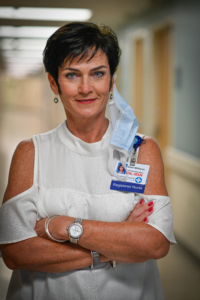 In March, we had our “dress rehearsal” for what was to become our actual event in June. During the spring, our Senior Team dedicated long days, seven days a week, to be as well prepared as possible, to think through eventualities. We were well aligned in base philosophy of providing best possible care and safest work environment possible. The only questions were the “when” of each new implementation, never the “what” or the “why”.
In March, we had our “dress rehearsal” for what was to become our actual event in June. During the spring, our Senior Team dedicated long days, seven days a week, to be as well prepared as possible, to think through eventualities. We were well aligned in base philosophy of providing best possible care and safest work environment possible. The only questions were the “when” of each new implementation, never the “what” or the “why”.
After weeks of preparation, I remember thinking to myself one morning as I was getting ready for work….hmmm, wonder who of us on the Senior Team will be the first to inevitably get sick? By mid-morning, that question was answered, when we learned that our Chief Nursing Officer, Daphne Blake, had tested positive and in fact was being hospitalized. What a shock that was, and a reinforcement to us all to make sure that we would all remain sufficiently knowledgeable to pick up and take care of different areas of responsibility as needed.
Immediately, Rhonda Unruh (VP of Quality) and I picked up the Daphne’s essential role, in coordination with our many dedicated and smart nurse managers. It was surreal to know that Daphne was admitted one unit over, while we were all gathered in the adjacent rehab exercise area making plans to renovate it within hours into an intensive care unit. We spent hours and hours planning staffing, reviewing PPE availability, and creating protocols.
But as challenging as that was, nothing compares to the sadness that hits me every time I think about the unnatural situation we are living. Never in my long career as a nurse would I have fathomed a world where family members are separated from their ill and dying loved ones, where walls and windows stand in the way of held hands and embraces. It makes me cry to think of it; I can only imagine the deep pain of those who are living it.
One early morning I was coming into work and crossed paths with an ICU nurse who was just leaving her night shift. She was obviously distraught, and shared with me how a few hours earlier she was holding up the hand of her dying patient while the patient’s adult son stood outside the glass room door. The nurse would walk to the door so she could hear the son and then relay the message to his mother. In this manner, the nurse communicated the son’s final goodbye to his mother. This disease is so unpredictable; there is no known course. Dealing with this disease is made all the more difficult with the masks we must wear, not being able to see and read faces. The federal guidance we have received is constantly in flux as well, adding to the uncertainty.
Everyone here at GRMC took this event personally, spending long hours and working hard. It seems the urgency and severity of the situation pulled all of us back to the core reason we pursued a career in healthcare – to take care of others.
One of the many heroes to do phenomenal work is Maria Corriveau, director of the laboratory. She single handedly coordinated the complicated set up and process for the various COVID virus testing modalities, including the Cephid, the Biofire, the Sofia and the IGG/IGM antibody tests and panels. She pro-actively arranged back up systems with CPL and University Hospital in San Antonio, as well as personally overseeing every single result for accuracy. Because the testing kits were allocated to us by the federal Department of Defense, we had to maintain a close eye on our inventory and develop triage protocols in coordination with Dr. Sangha to determine which patients required the most rapid method of testing. The lab staff also came up with innovative ideas to improve patient care and safety, such as drive up testing capability.
During the many weeks of our patient surge, we were all working from adrenaline, pushing ourselves to our maximum, connecting on a very visceral level to do our best. I worry about the emotional long term consequences for all who experienced the deep sadness and trauma of this event. It reminds me of responding to a pediatric code, where everyone pulls together and works fervently to rescue the child, and only later does the reality of the event hit you hard.
Carole Harrison, PT, Director of the Inpatient Rehab Unit
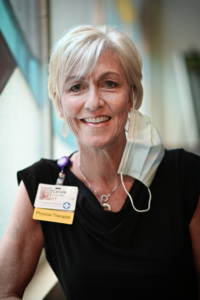 GRMC’s strong foundation of high expectations, an accountable culture, and an emphasis on quality care have all contributed to our amazing COVID response. Leadership at GRMC makes sure we are all well informed and interconnected – we do not operate in “silos”. That teamwork/family spirit has helped us all be flexible and to accept our new role in providing rehabilitation care to recovering COVID patients.
GRMC’s strong foundation of high expectations, an accountable culture, and an emphasis on quality care have all contributed to our amazing COVID response. Leadership at GRMC makes sure we are all well informed and interconnected – we do not operate in “silos”. That teamwork/family spirit has helped us all be flexible and to accept our new role in providing rehabilitation care to recovering COVID patients.
My job is to make sure my staff are safe and prepared. I am so impressed with the level of preparedness that the hospital has provided, such as with the extent and quality of PPE. I know our Employee Health Nurse is 100% committed to our staff, ensuring same day testing as needed, and caring deeply for each of our employees.
Each of us in the IPRU department had to push ourselves out of our comfort zone to begin treating COVID patients. It is not an easy thing to take care of highly contagious patients, knowing that we could get sick or bring home illness to our families.
Many of these COVID patients had been on a ventilator for weeks, or suffered a stroke. They are weak and debilitated, and not yet safe to return home. Our job is to literally get them back on their feet and ready to live independently again. I am so proud of each of our staff members, from Dr. Zhang to the nurses, therapists and aides, who have all committed to safely facing this virus head on, with uncompromising passion.
Deana Henk, CEO of the Guadalupe Healthcare Network (GHN)
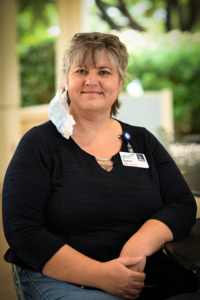 The role of GHN is to facilitate managed care contracts with payers between GHN’s physician and hospital members. In my role here for over 25 years, I have developed strong relationships with physicians in Seguin, New Braunfels and the outlying rural communities, as well as with local employers. Those employers include the school districts and government entities. When the COVID surge hit our region, I realized that GHN had an unexpected and important new role we could play connecting all those groups and individuals.
The role of GHN is to facilitate managed care contracts with payers between GHN’s physician and hospital members. In my role here for over 25 years, I have developed strong relationships with physicians in Seguin, New Braunfels and the outlying rural communities, as well as with local employers. Those employers include the school districts and government entities. When the COVID surge hit our region, I realized that GHN had an unexpected and important new role we could play connecting all those groups and individuals.
When the Governor decreed a state emergency in March, the Seguin medical community and hospital quickly responded with an “all hands on deck” attitude. It became quickly obvious that the physicians of our community were woefully undersupplied with PPE. Most doctors only have rare instances of needing to gown and mask in their office for an infectious patient, so almost none had basic supplies, and certainly not enough N95 masks. By March, suppliers were running out of inventory, the State was buying up surplus, and because our region was (not yet) a hotspot, we were not considered a priority. Frustratingly, State guidelines prioritized those who should receive any PPE distributions as #1 hospitals, #2 nursing homes, and #3 physicians.
So physicians, the front line of our health care system, were in the back seat for receiving PPE. GHN represents over 250 regional physicians, and I made it my mission to make sure that they would in fact be well supplied. Using our local Chamber and Economic Development connections, my first stop was to solicit local employers, many of whom were temporarily shut down and who use PPE in their ordinary line of industrial work for donation of supplies. The Seguin business community, both large and small, were overwhelming in their immediate support: For example, Vitasco donated gowns and shoe covers, CMC donated supplies, the Seguin ISD health care labs collected gloves and gowns, and local resident Tess Coody helped to gather PPE from all the science labs at Trinity University. Patrick Pinder, Guadalupe County’s Emergency Management Coordinator, was wonderful in coordinating mask collections as well.
Within a few weeks, GHN was permitted to request and obtain PPE supplies from the South Texas Regional Advisory Council on behalf of our physicians in Guadalupe, Comal, Wilson and Karnes counties. This required frequent trips to former Kelly San Antonio Air Force Base, to pick up boxes, then later pallets full of PPE for distribution to our primary care and specialty physicians. As of mid-August, I’m proud to say that we had distributed over $1M worth of PPE to our physicians and their offices, and along the way I have become extremely well educated on all the types and uses of protective equipment! I am also proud to be part of the GRMC system – the physicians of Seguin, New Braunfels, Floresville and Kenedy have all commented on the tremendous support that we have provided them in this time of need.
In addition to the PPE distributions, GHN has tried to be a source of COVID information, both from a payer perspective as well as by initiating weekly phone calls to review and discuss developing local trends and CDC diagnosis and treatment protocols. This provided physicians a forum for collaboration and coordination.
GHN helped coordinate insurers and educate local physicians on the quickly emerging need for telemedicine. I am so impressed with the adaptability of our docs to quickly change course from face to face visits to telemedicine in a matter of weeks. In my regular discussions with local employers and school districts, I understood their logical frustration with the myriad and confusing federal and state guidelines they were trying to navigate related to COVID. CDC guidelines for returning symptomatic or positive testing employees to work were constantly changing. CDC direction for re-opening schools at times directly conflicted with TEA guidelines, creating unclear grey zones for interpretation with very little preparation time. GHN and GRMC administration both worked to establish regular communication and guidance, along with local governmental officials, with area employers and school superintendents. Because Seguin does not have its own local health department to support or advise employers or schools, GRMC and GHN worked to fill those holes as much as possible.
There are so many heroes that have emerged during this time! A few I would like to highlight include Rhonda Unruh, Sheri Williams and Daphne Blake for their consistent reliable information and communication. Physician leaders such as our hospitalists; Drs. James Rider and Michele Lopez- Glynn who helped lead communications with employers and schools; and Drs. Emily Briggs and Dorothy Overmann, New Braunfels Family Practitioners and public health experts for their solid guidance. Community leaders Patrick Pinder and Judge Kyle Kutscher have been great partners, as have all the Guadalupe County superintendents (Dr. Matthew Gutierrez, Clark Ealy, Wendi Russel and Kelly Lindholm), who have gone above and beyond in trying to balance the needs of students, parents and school employees in this uncertain time.
I was born at this hospital, raised in Seguin, have built my entire career at GRMC/GHN, and am very deeply rooted in this community. I am so proud of who we are as a community, caring for each other at each step of this uncharted road, doing the best we can to ensure that all of us emerge from this crisis safely and united.
Travel Contract Staff
The phenomenal response to the crisis at GRMC was due in great part to hospital preparedness and culture, but much credit must be given to the highly skilled traveler nurses and respiratory therapists who came from all over the country to help during these crucial weeks. Below are a few quotes from three of the almost thirty travel staff who came to help GRMC.
I
“I was struck by how well the GRMC staff had this emergency under control compared to the chaos I saw in NYC. While some might think that a big city and a big hospital would provide the best care, I actually saw the opposite. In NY, there were never enough staff, or ventilators, or other
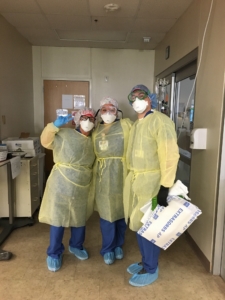
needed equipment. Half the time we were out looking for equipment. I had to wear my issued N95 mask for one week at a time. Sadly, the situation was such that not every patient had the care they needed to live. At GRMC, however, they ensured we had all the PPE we needed, and we never wore the same N95 mask for more than one day. The patients were constantly monitored, we had sufficient staff, and the staff made every possible opportunity to ensure that patients and family could communicate despite no visitor policy. I am so impressed with how everyone here works together to take care of the patients and the staff.”
II
“Back home I work as a trauma ICU nurse at a large Level 1 hospital. When the situation started exploding in New York, I decided to volunteer to help for a 13-week stint. Of course, I expected some chaos, but I was shocked to see that the entire health care system there seemed broken.
The rest of the country had the advantage to learning from the New York crisis, but they truly were thrown into a storm with no guideposts. Many of their own staff had become sick and were either hospitalized or home, so hospitals were already understaffed. And the number of incoming patients critically sick due to COVID was unbelievable. I was assigned to a 9 bay ICU in a teaching hospital. Patients were doubled up, two to a bay, and the halls were overflowing with another 12 patients all under our care. Some of the patients had already passed away, but were still laying in their stretchers alongside the sick patients.
It is an understatement to say we had insufficient PPE, supplies, and equipment. It felt like a third world country, having to share monitors between patients, having to wear our own N95 masks for a week at a time, running out of medications, impossible to provide quality care. It was tragic. It was also surreal, as the few times I did leave the hospital I found myself absolutely alone in Times Square – not even the homeless were out and about.
When I heard that Texas was also in need of additional nurse staffing for the June surge, I signed up for that assignment as well, and found myself here in Seguin starting June 27th. Thank goodness I came here. Every single person has been so nice and welcoming.
More importantly, the care for staff and patients here is fabulous, such a contrast to my New York experience. We have plenty of PPE, the staff here is very dedicated to excellence, appropriate staffing is provided as needed even if that means one-on-one care. The hospitalists are wonderful; they help the nurses and teach us a lot. It is clear that with better care, like what I have seen at GRMC, the patient outcomes are absolutely better than what I saw in New York. We are all so motivated to help our patients recover and return home to their families.
It is definitely one big family here at GRMC. It is nice to see the strong family support shown by the relatives of the patients, though it breaks my heart that they are not allowed to enter into the hospital and be with their loved one. The other day one family gathered in the evening outside my patient’s window, each with a harmonica or musical instrument, and gave him a concert.” 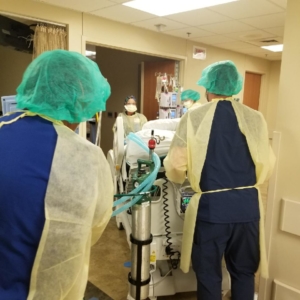
III
“I’ve been in some form of health care all my adult life, though I have been a traveling nurse for several years and have worked at dozens of hospitals. I volunteered to spend six weeks this spring helping with the COVID response in New York, where I was assigned to a hard hit area of the Bronx. I fell in love with the people of New York. They were so grateful, so resilient, so strong in the face of their overwhelming challenge and chaos.
Actually I was apprehensive about coming to a “small town hospital in Seguin”, but instead I feel like I have found a unicorn, it is such a unique outlier in the health care world. People here work together so well, you can tell that the staff really cares about the patients, each other, and the community. It is
common to meet someone who has worked here for decades, with deep loyalty to the organization. I can think of no higher compliment then to say that I would no doubt bring my own family to GRMC for care due to the quality, collaboration, and cohesiveness I have seen.
Drs. Arenas and Lester are so very smart, yet they listen to the nurses opinions and consider us an essential part of the health care team. You can find smart doctors at other hospitals, but often there is very little interaction with nurses or therapists. The system here is also very efficient and streamlined. Everyone knows the plan, everyone does their part, so therefore there was no chaos even during our peak days.
There are many obvious differences between my New York and Seguin experiences. In addition to the geographic differences, there are also “geometric” differences. In Texas, people are really spread out. In NYC, people are literally on top of each other, packed together, and in much older infrastructure. Those factors made the virus all the worse in NYC.
What was not different between the two places was the devastation of the sickness itself. I am always shocked to see how the virus affects people so unpredictably, without rhyme or reason. I have seen 30-year olds who were deathly sick, and 90-year olds who recovered well. You simply cannot predict the course of this illness like you can with other diseases.
I wish people could watch a film of the inside of a COVID unit. They would see a diverse and dedicated health care team working hard to help others. They would see that there is no color or political divide here. They would see that this disease is awful, and that the pain of not having family members at the bedside is a tough reality for patient and relatives. It seems to me that many critically ill COVID patients try to extend their lives for additional days, waiting for a chance to say goodbye in person to their loved ones. I think that if people could see the sadness, seriousness and randomness of this disease, we might all be able to get past the silliness of not wearing masks. I know that I will always remember GRMC, this “unicorn” of a hospital.”
Virginia Sanchez, wife of COVID patient Jose Lopez
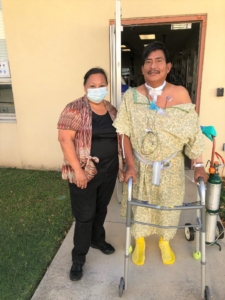 My husband and I were at home on Wednesday, July 8th, when he started coughing and running a slight fever. I pushed him to go get tested for COVID, so we went to the ER for the test but were told that the results would not be available for a few days. The next morning he felt better, and returned to his job doing yard work. Later that day he felt bad again, but that didn’t stop him from going back to work on Friday. On Saturday we received the call that he was in fact positive for COVID, that news hit us hard.
My husband and I were at home on Wednesday, July 8th, when he started coughing and running a slight fever. I pushed him to go get tested for COVID, so we went to the ER for the test but were told that the results would not be available for a few days. The next morning he felt better, and returned to his job doing yard work. Later that day he felt bad again, but that didn’t stop him from going back to work on Friday. On Saturday we received the call that he was in fact positive for COVID, that news hit us hard.
His fever and coughing continued over the weekend, we were treating it with cough syrup and rest. Monday afternoon he was feeling really bad, and his daughter came by with a pulse oximeter. It read 60, which is really low and a bad sign. He kept saying, I’ll be okay, let’s just wait a little bit more. By early evening the pulse oximeter said 40, and I insisted we go to the hospital right away. By this time he could barely stand up. I told him I would call an ambulance, but he said no, I can get up. Somehow he managed to do so, and get in the car.
When we arrived to the ER parking lot, the staff came out to help us. I could not go inside, since visitors are not allowed. So that moment was the last time I had been with him. After that, he was rushed to the ICU.
I have been coming here, sitting outside his ICU window, every day, three times a day, since then. I come around 8am each morning since it is not so hot then, and stay a couple of hours. I check back in around 2pm, and then return every evening from about 5:30pm to 9pm. I bring this folding chair, and pray, and talk to the nurses every afternoon on cell phone. For several weeks he was on the ventilator, and we were not sure he would even survive. Now he is thankfully getting better, he is off the ventilator, and he and I can talk through the window. He has even asked me to bring him some pants. Today the therapist is helping him walk.
Jose has never been sick in his life. He is a strong man, 55 years old. We are not sure where he picked up this virus. Maybe it was from me. I was sick for a few days in June with fever and cough, but my test showed twice that I was negative. Since this whole thing started, neither of us have been able to work, so money is tight. He does not have health insurance. But we trust in our faith.
I have come to know several other families who also were visiting their loved ones in the ICU. We take care of each other, bring each other water or food. I have seen three families recently lose their family member. It is sad and scary. It is hard that we cannot even hug each other.
At first, some of our family suggested that he be transferred to a San Antonio hospital since he was so sick. But I said no, I wanted him here so that I could visit him every day. I am so thankful for the care he has received. The doctors and nurses have been very nice, taking such good care of him and keeping me informed all along the way. I am praying for him to come home soon.
(After more than four weeks in the ICU, Mr. Lopez was discharged home in late August, to the joy of his wife and family!)
Trish Debold, RRT, Cardiopulmonary Therapist
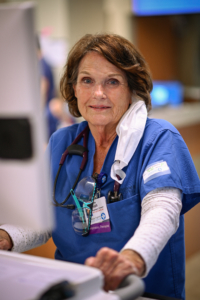 I started my health care career late in life, at the age of 48, but I certainly consider this my life’s calling. I love what I do, and I give my patients my all each day. But I must admit I felt overwhelmed and helpless by the new level of sickness that this virus brought.
I started my health care career late in life, at the age of 48, but I certainly consider this my life’s calling. I love what I do, and I give my patients my all each day. But I must admit I felt overwhelmed and helpless by the new level of sickness that this virus brought.
We can never assume that we know what will happen in a patient’s course of care, but with COVID, all bets are off. You could be talking normally with a patient one minute, and in a matter of hours they had deteriorated so fast that life support was needed.
I will never forget one COVID patient, who impacted me deeply. Though she was in her 50s, this special lady had a remarkable childlike innocence with a sweet and trusting demeanor. While I was giving her a breathing treatment one day she asked to call her mother to introduce her to me, calling me her “new BFF”. She asked me to fix up her hair to prepare for the doctor who was expected any minute. Her situation was worsening, and in fact Dr. Sangha had to explain that we needed to proceed with intubation and a ventilator. She called her mother again, told her that she loved her, and peacefully explained, “Mom, I’ll see you on the other side!” Sadly, she did pass away a few days later, with her mother outside her window and me holding her hand.
There were other cases, like a bus driver from San Antonio, who was so sick he coded three separate times, but in fact he beat the odds and recovered, returning home. We were all so encouraged to see these successes.
Everyone was working hard, long hours and days; we were all exhausted. One day while at work I came down with the worst headache of my life, and found that my temperature was over 100 degrees! I knew it must be COVID, and sure enough, I tested positive and made arrangements to return home immediately. My husband and I had already been quarantining in separate sides of the house since March because I was at such high risk. That began my 33 day adventure in shortness of breath, nausea, vomiting, fatigue, and every symptom associated with the disease. My wonderful colleagues and Dr. Lester made house calls, Dr. Sangha checked in on me daily, everyone gave me wonderful support and medical care. My husband was blown away, seeing how my work family went way above and beyond to help me, and can’t thank them enough.
I too was blown away by our doctors, who were working nonstop. No doubt, their one-on-one care saved many lives, being at the bedside and so in tune with each patient’s course. The PPE made us all so hot and sweaty, that we joked that we could hear each other coming, our shoes squeaky from our sweat. I was also so impressed with our administrative team, always there for us providing needed communication and supplies. I have a hard time accepting the word “heroes”. I think we all feel as though we are simply doing our jobs, and that it is a God given gift to have the ability to provide care and compassion to those in need.
Fay Bennett – VP of Employee Services
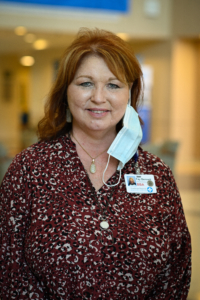 I will never forget the day of Friday, March 13th, when it became clear to our Senior Team that the virus was indeed going to enter our part of the world, that we were crossing a threshold of no return, and that our lives would be altered for an indefinite period of time. I have experienced that same feeling before years ago, when my husband was critically ill. I remember feeling that same shudder and lack of control but knowing that faith and trust had to fill the void of the unknown ahead. By June that prediction came true when the patient surge hit.
I will never forget the day of Friday, March 13th, when it became clear to our Senior Team that the virus was indeed going to enter our part of the world, that we were crossing a threshold of no return, and that our lives would be altered for an indefinite period of time. I have experienced that same feeling before years ago, when my husband was critically ill. I remember feeling that same shudder and lack of control but knowing that faith and trust had to fill the void of the unknown ahead. By June that prediction came true when the patient surge hit.
We had very little outside guidance, as everyone around the planet and country was still trying to figure out best practices for managing the virus. We were very fortunate to have the calm, unwavering leadership of our CEO, Robert G. Haynes, who continually reminded us that this was a marathon and not a sprint, and that we needed to pace ourselves.
GRMC’s ability to adapt has never been more evident than during the past few months. One example was the newly implemented screening stations at each hospital entrance, and the many ways that we continued to update and improve the process. The task of staffing and providing necessary supplies for the stations became a full time job, and became one of many ways that allowed our employees and volunteers to contribute and help.
So many employees stepped up to make a huge difference in this time of crisis! Pastoral Care, Palliative Care and the Teddy Buerger Center staff were quick to provide spiritual and mental health support to staff, patients and families. Employee Health and Materials Management became 24/7 departments in order to meet the increasing needs of the Medical Center.
I have been especially saddened by the many tough situations that this pandemic has created…. isolated and lonely volunteers at home, patients separated from their families, staff who have been hit hard due to this illness or family members losing a job. I have also been very heartened to see the deep generosity of our more fortunate staff members who have pitched in to provide financial assistance and emotional support, and for the community’s overwhelming generosity and baskets of appreciation and encouragement for our staff.
HR performed hundreds of mask fit tests. Every time there was a new type of N95 mask available, we had to test our front line workers to make sure that they provided a sealed fit. Our top priority was always staff safety and supporting our front line workers. I am filled with pride for what our hospital family accomplished during this extremely difficult time. We never furloughed a single employee, in contrast to most hospitals around the nation. Our team spirit and morale grew even stronger.
In fact, this year we have again been named as one of the Modern Healthcare Magazine’s top 100 best healthcare employers in the country, in large part because our 800+ employees recognize that they are deeply valued and that we have a robust culture of caring and safety. I never in my wildest dreams imagined I would be living through a pandemic, but I cannot imagine a workplace where I would rather be while dealing with the awful impacts of this virus.
I mentioned that I have experienced this same fear of the unknown when my husband Gary was facing an unexpected health crisis. Today he is healthy and working and we are enjoying life together. Just as our family weathered and survived the storm of his illness, I have faith that our collective lives will someday return to the simple “normals” we all enjoyed before this pandemic. Until that time, I pray that our community continues to take the threat of a second resurgence very seriously.
Brandy Solis, Certified Nurse Aid and Health Unit Coordinator, Operating Room
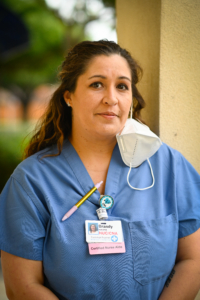 My family has deep roots in Seguin. My father, Reynaldo “Rey Bob” Solis worked as an electrician and security guard his whole life here, my mother, Ester, retired from Motorola after thirty years. They were well connected with lots of friends and family, never met a stranger, and recently celebrated their 51st wedding anniversary. My two sisters and I went to school in Seguin, and now all three of us work in some aspect of the health care field.
My family has deep roots in Seguin. My father, Reynaldo “Rey Bob” Solis worked as an electrician and security guard his whole life here, my mother, Ester, retired from Motorola after thirty years. They were well connected with lots of friends and family, never met a stranger, and recently celebrated their 51st wedding anniversary. My two sisters and I went to school in Seguin, and now all three of us work in some aspect of the health care field.
My mother and I were busy planning a baby shower for my daughter in early June. I figured the scratchy throat that was bothering me at that time due to was allergies or that African dust storm. The next day, though, I was achey all over, and then I started having a fever. I went to the Emergency Department for a test, went back home to quarantine, and then two days later I got the call that I was in fact positive.
The symptoms only got worse while I was quarantining alone in my bedroom. By day ten I was begging God to take this virus away, I was so miserable. It seems like everyone thinks, “I bet that bug I had a few months ago was COVID, I bet I’m already immune”. Heck, I thought that myself. But I have NEVER had symptoms like this. I felt like someone had beat me up with a baseball bat – my back, ribs, kidneys, every part of my body felt awful. My cough lingered another ten days, but I did recover and returned to work.
While I was quarantining, my mom called to tell me she felt sick too. She got tested, and learned she too was positive. Of course I could be no help to her, we were both in quarantine in our own separate houses. At age 71, my mom is healthy as a horse, she even is a regular at the Zumba classes at the
wellness center. But the virus made her very sick, disoriented, and she started sleeping the whole day.
Soon after, my dad started feeling sick too. We were all worried when they didn’t answer their phone. My sister offered to take them to the Emergency Room, but by this time they didn’t have the energy to get out of bed. An ambulance was called, and they were both immediately admitted straight to the COVID ICU. I was fortunate to know the staff here personally, so I warned his first nurse that my dad would be a difficult patient. He and I are both known as the stubborn ones of our family. Sure enough, he was agitated, fighting for air, non-compliant with his BiPap breathing treatments, and he was not doing well.
Our whole family and our priest visited both our parents through their separate ICU windows. I will always remember the kindness of Isaac Camacho, his nurse, who met us at the doors to take from us the rosary that Father David had just blessed, to wrap it around my father’s wrist. My parents were admitted to the hospital on June 17th. On June 30th my father passed away, just a few doors away from my mother who was still battling the virus. The following day Dr. Sangha informed my mother that he had passed, while she was alone, without us to hold her or cry with her.
My mother slowly began to recover, to the point where she was able to go to a rehab center in New Braunfels. But because she was still testing positive, we still could not be with her. Once again, we could visit her only through the window. Our family held a very small rosary ceremony for my dad on August 6th, but my mother was still in rehab and could not attend.
When my mother was finally released from the rehab center, I was able to go pick her up and at last hug her tightly and share our grief together. We are planning a funeral in September, at which time we will bury his ashes in the family plot near his parents.
What would I tell people based on my experience? First, don’t assume you know if you are sick or contagious, even if you don’t have symptoms. Masks work, be courteous, respect the fact that this virus can infect others and can cause horrible sickness and death. I would not wish this sickness on anyone. Hold on tight to your kids, parents and loved ones.
How have I changed as a health care worker as a result of this horrible experience? I volunteered to work in the COVID unit, in fact. I wanted to treat every patient there as though they were my mother or father, going the extra mile to take care of their needs and help compensate for the fact that their own family cannot be at their side.
I have such deep respect for the heroes like Dr. Sangha, who is so smart, never frayed….I don’t even have the words to express my gratitude for him. He would come outside and talk to us in the heat, outside the windows, always so considerate of our feelings. I am now in process of taking my entrance exam for nursing school – this experience pushed me to follow the example of all the wonderful nurses who took such excellent care of my parents.
Teresa Laechelin, GRMC Volunteers CEO
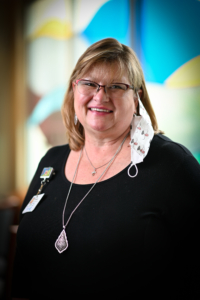 I have had the privilege of working at GRMC for the last 16 years, and the honor of leading the terrific group of over 150 Volunteers who provide an essential component to the care that is provided all over our campus.
I have had the privilege of working at GRMC for the last 16 years, and the honor of leading the terrific group of over 150 Volunteers who provide an essential component to the care that is provided all over our campus.
In March when the statewide emergency was proclaimed many factors were considered with regard to the safety of the GRMC Volunteers and the many services they offer. Risking the health of some of our volunteers was not a risk we were willing to take. We also made the decision to cancel the annual Volunteer Appreciation Luncheon and many of our popular programs such as our Junior Volunteers, Student Shadowing, and Fundraising opportunities which raise funds to support our Scholarships and facility donations.
We made the decision to close The Gift Shop at GRMC during this emergency. The “Mobile Gift Shop” was then created to provide a shopping experience to our staff that work tirelessly providing patient care as well as the day to day operations of GRMC.
The Volunteer Services Department found another opportunity to provide assistance by lifting some of the burden of the administrative tasks associated with the screening stations put in place to assure the safety of all staff and patients that came into GRMC during this crisis. We made sure that the stations were fully stocked with supplies on a daily basis and provided training for staff who worked the stations from morning to night and was a resource for questions that arose.
As a resource for the screening stations one of the most difficult things we had to do was inform family members that they could not accompany their loved ones who were coming in for surgery or diagnostic tests. Even if the patient was not a COVID positive patient, we were mandated by the State not to allow any visitors into the hospital. Our goal was to assure the patients and their family that they could count on us to provide excellent care, and to treat each patient as though they were our own family.
As things began to subside in June we invited the Volunteers to return to their normal schedules. Some did return, however when we experienced a surge in July most decided that quarantining at home was in their best interest and without visitors our day to day traffic was significantly reduced. Currently we have reopened The Gift Shop for staff and patients in the hospital. We are looking forward to when we can allow the community back in to shop. I often think about our many Volunteers, currently at home and often isolated from the social activity that they enjoy here. However, I also know from seeing the patient surge at GRMC this summer that this disease is very serious, and I am so glad that our Volunteers are wisely being cautious. Some of our Volunteers have started to come back to help where there is a need. The GRMC staff and I look forward to having our Volunteers return in full force.
Manny Alvizo, Social Worker and patient at GRMC
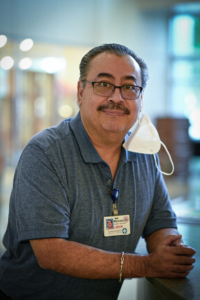 My wife, an avowed germophobe, and I have been taking the threat of this virus very seriously for months. Outside of my work at GRMC, she and I rarely left that house and when we did we took all the recommended precautions. I changed clothes in the garage before entering the house, to be extra careful about not bringing in germs and would go straight to the shower before interacting with my family. At work I was very disciplined about wearing my mask and with all interactions with patients and coworkers. The two other co-workers with whom I share an office agreed we would no longer eat lunch in the hospital cafeteria and instead ate in our office. That was the only place where I took off my mask, to eat at my desk.
My wife, an avowed germophobe, and I have been taking the threat of this virus very seriously for months. Outside of my work at GRMC, she and I rarely left that house and when we did we took all the recommended precautions. I changed clothes in the garage before entering the house, to be extra careful about not bringing in germs and would go straight to the shower before interacting with my family. At work I was very disciplined about wearing my mask and with all interactions with patients and coworkers. The two other co-workers with whom I share an office agreed we would no longer eat lunch in the hospital cafeteria and instead ate in our office. That was the only place where I took off my mask, to eat at my desk.
Well, that small act was apparently, where I got infected. Unbeknown to me one of my coworkers, her sudden flu-like symptoms turned out to be COVID, and apparently during one of our shared lunches in late June, with both of us sitting at our own desks, I was exposed. She went home feeling lousy on Friday June 25th. By that Monday evening, I started feeling odd, hands clammy, slight fever, my wife said I looked pale. The following day we arranged for a test, and sure enough, I was positive. Unfortunately, by that time I had also infected my wife, who soon started exhibiting signs as well. We quarantined together at home, with our two adult daughters caring for us while we dealt with fatigue, fever, and headaches. But the pulse oximeter showed our oxygen levels still in the high 90s. Dr. Lester soon became Saint Dr. Lester to me as she called frequently checking on me and guiding my care.
On my 10th day of sickness, however, my fever actually got worse and my oxygen level fell below 90. I agreed to come into the ER to be checked, thinking that they would give me some medicine and I would return home. That was not to be, as instead breathing became a struggle and my oxygen levels dropped into the 80s. I was admitted into the PHE unit that evening.
I don’t remember the first couple of nights very well, other than struggling to breathe and starting to think of the worst possible outcomes. Dr. Lester continued to take care of me, prescribing Remdesivir, plasma, steroids and antibiotics for what had now developed into bilateral pneumonia. I am a borderline diabetic, always controlled with diet alone, but now that condition was made more complicated by the steroids. Otherwise, I had been in excellent health before this illness hit me.
Nine days later I was finally discharged, grateful for the amazing care and concern I had received from everyone who entered my room – the docs, nurses, aides and housekeepers. Justin Love, my main day nurse, even brought me word puzzle books to keep me busy during those long days alone. Pablo, my night nurse, helped me get through my insomnia. I wondered if I was getting VIP treatment since I am a GRMC employee, but I saw that each of my roommates were given the same level of personal care too.
My job at the hospital is as a Case Worker, which means I help patients set up plans for their continued medical care after discharge. Suddenly I was on the other end of that role, as a patient needing oxygen and medical equipment at home and having to coordinate with insurance to provide coverage. I was thrilled to get home, but unfortunately, my condition worsened again. I was having trouble talking and breathing, and Dr. Lester insisted I return to the hospital. At this point it was decided I needed to undergo a bronchoscopy performed by Dr. Sangha. Dr. Major, who provided the anesthesia for me, was so comforting and kind, and prayed along with me before the procedure. I felt the prayers of many around me, which gave me great peace during the next few days of being in the hospital.
On July 31st, I was discharged home for the second time, and now I continue to improve. I am astounded at how this sickness blindsided me – one day I was fine, the next day I was really sick. The symptoms kept changing throughout. My wife did not get as sick as I did, she was able to stay at home and recover, but she still has lingering symptoms. Now I am building up my endurance and strength, both of which have been badly affected.
As a GRMC employee, I always knew we provide excellent care. As a patient myself, I am even more convinced that this is a wonderful place with amazing caregivers. I feel very fortunate.
Lauren Riggs, RN, BSN, Clinical Coordinator for the Birthing Center
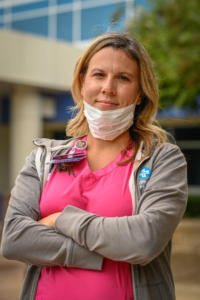 As the hospital began to ramp up its preparedness plans for COVID patients, our unit director Janelle Tharp and I began attending weekly webinars sponsored through San Antonio’s University Hospital and the Alliance for Innovation on Maternal Health. We began collaborating with Clinical Quality to develop strategies to minimize exposure of maternity patients to other areas of the hospital. We also wanted our expecting moms to feel safe coming to the hospital so a separate and direct entrance to our unit was created. We developed an OB specific algorithm for patients presenting to our unit with COVID symptoms. In both the second stage of labor and during C-sections, all staff began wearing N95 masks given the potential for aerosolized droplets of contagion. Our department is unique in that we care for patients in many different phases of care-in triage as outpatients, during labor/delivery, in our Operating Room, recovery, and during the postpartum period.
As the hospital began to ramp up its preparedness plans for COVID patients, our unit director Janelle Tharp and I began attending weekly webinars sponsored through San Antonio’s University Hospital and the Alliance for Innovation on Maternal Health. We began collaborating with Clinical Quality to develop strategies to minimize exposure of maternity patients to other areas of the hospital. We also wanted our expecting moms to feel safe coming to the hospital so a separate and direct entrance to our unit was created. We developed an OB specific algorithm for patients presenting to our unit with COVID symptoms. In both the second stage of labor and during C-sections, all staff began wearing N95 masks given the potential for aerosolized droplets of contagion. Our department is unique in that we care for patients in many different phases of care-in triage as outpatients, during labor/delivery, in our Operating Room, recovery, and during the postpartum period.
In order to prepare for a potential surge, our normal work flow had to be altered to create a separate section within our department designated for COVID positive moms. Based on state guidelines for hospital visitor policies, the maternity department limited visitors to only one support person per patient. This policy was well received by new moms and dads, providing more time to privately bond with their newborns. As of this writing, there have only been two COVID positive moms deliver at GRMC. Newborns are tested for COVID infection at 24 hours of life per AAP Guidelines, but both of these newborns tested negative.
Steve Ratliff, Director of IT
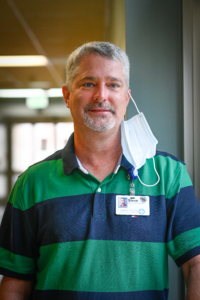 March 1st was our “Go Live” date for our long-planned hospital-wide electronic medical record system implementation. To our great surprise, 12 days later we were dealing with COVID “Go Live” response.
March 1st was our “Go Live” date for our long-planned hospital-wide electronic medical record system implementation. To our great surprise, 12 days later we were dealing with COVID “Go Live” response.
Our team of IT experts provide the underlying infrastructure for hospital communication. Once the decision was made to allow 80 office staff to work from home, IT had to quickly implement a brand new, untested system for remote work. It went very smoothly.
We increased our number of Zoom licenses and laptops, allowing our inpatients to connect with their family members during this period of no visitors being allowed in the hospital. Audio conferencing became increasingly useful for staff conferences and meetings to ensure social distancing.
As the hospital began receiving help from contract nurses and cardiopulmonary therapists, the IT staff jumped right in to provide immediate electronic medical record training, seven days a week. And as new COVID units were being established, IT and related departments were quick to ensure the right equipment, scanners and order sets were available. Like with other staff around the hospital, our IT team members are “owners”. We own our responsibility, we care about the staff and our patients, and we love our jobs.
James Lee, MD, retired family practitioner and Chairman of the GRMC Governing Board
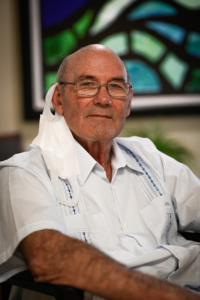 I recently read and highly recommend the book, The Great Influenza: The Story of the Deadliest Pandemic in History, about the virus spread of 1918. That tragedy was so much worse than what we have experienced to date in this pandemic. It affected the entire world in two different waves, which makes me worry that we might also experience another worldwide wave without an effective vaccine.
I recently read and highly recommend the book, The Great Influenza: The Story of the Deadliest Pandemic in History, about the virus spread of 1918. That tragedy was so much worse than what we have experienced to date in this pandemic. It affected the entire world in two different waves, which makes me worry that we might also experience another worldwide wave without an effective vaccine.
While it was called the Spanish Flu, it is believed to have actually started in Kansas at a military base. As with today’s virus, there were many political undertones to that event. It was so devastating to the Germans that it actually changed the outcome of World War I, and caused millions of deaths around the world.
When it became evident that the virus could affect our own region, I emphasized to Mr. Haynes (CEO) that our Board needed to simply step back and let him and the staff do their jobs. Our role was to support them, and to recognize that the organization might suffer millions of dollars in expenses but that we needed to do whatever was needed to care for our staff and patients. The Board, and full hospital staff, began receiving weekly email updates full of information regarding regional and local cases, and communication on how the hospital was quickly morphing as needed to accommodate the influx of patients.
I know that patient care units were set up to admit as many as 50 COVID patients at a time, though the maximum we reached was still an astonishing 44 at our peak. The hospital was in a solid position to deal with this crisis, from our financial footing to excellent staff and of course very fortunate to have the expertise of Dr. Sangha.
The Board also adjusted to having Zoom meetings, though a portion of us continued to attend in person, masked and socially distanced. I know several local organizations, like my Rotary Club and my wife’s Shakespeare Club, have been very challenged trying to remain connected under these new circumstances that do not allow for in person group meetings. I worry about the social implications that may come of this, but also realize that there is a good likelihood of another resurgence if our community lets it’s guard down too soon.
I am constantly amazed at the dedication of our hospital and medical staff, never more obvious than during this event which required clinical excellence and long hours in a potentially dangerous situation.
Michelle Rumbaut, Project Administrator
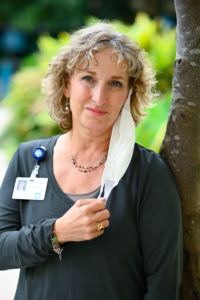 I started working for GVH 35 years ago as a newly graduated hospital administration intern. I have spent my entire adult working life at this hospital, and have had the privilege of being part of its many transitions and periods of growth.
I started working for GVH 35 years ago as a newly graduated hospital administration intern. I have spent my entire adult working life at this hospital, and have had the privilege of being part of its many transitions and periods of growth.
One of the roles I have enjoyed over the decades is that of writer, helping to put into written words both the history and vision of this organization. It is therefore my great honor to have been given the opportunity to interview these first-hand participants of the momentous pandemic event at our hospital, and to weave together their accounts and perspectives. In doing so, I have discovered a common thread in these stories.
COVID-19 is a mysterious, complicated, unpredictable disease. It seems to act as an accelerant, or magnifier, for underlying disease or weakness. Hence, a person with seemingly benign conditions like borderline diabetes or a history of childhood asthma may experience severe symptoms, critical illness, or even death when the virus infects the body. It is as though the virus exploits that vulnerability, making the medical situation worse.
In comparison, these stories have also illustrated how COVID acted as an accelerant or magnifier of our organizational strengths and culture at GRMC. The intentionally created foundation of trust, compassion, expectation for excellence, and honest communication permeated every decision during this rapid-fire event. It is as though placing the hospital’s culture under pressure enhanced the talents of each individual, allowing leaders and heroes to emerge, and turning a potentially disastrous situation into GRMC’s finest hour.
I echo the many sentiments of appreciation and awe expressed in these interviews, from so many different points of view. A great organization is made up of many extraordinary people, and extraordinary people grow to their utmost potential and passion within the folds of a great organization.

